🇰🇭 Backpacking in Cambodia

Siem Reap
At the start of July we flew from Bangkok to Siem Reap. We had already sorted out our 30-day e-visas, making entry pretty smooth, though the lack of tourists certainly helped. We also took a slight risk in not booking an exit flight, something that is stated as a requirement for entry, but evidently it isn’t since we didn’t get asked for one.
Stress on arrival
We had organised a pick-up from the airport via our Airbnb host. I was a bit surpised that it was a tuk-tuk but it only cost $3 so no complaints there – however – we ended up having a somewhat stressful start to our trip here. Cambodia uses both the US dollar and the Cambodian Riel, neither of which we had on arrival. The 2 ATMs in the airport kept erroring out with our (Monzo) cards – no problem, we’re kind of used to this – we just resort to our Revolut cards which tend to work better.
Guess who had forgotten to top up their Revolut cards! And in order to top up we needed internet, for which we needed SIM cards… for which we needed to pay in cash!
Before realising that we hadn’t topped up our driver patiently drove us into town to a few other ATMs which also didn’t work, at which point we awkwardly had to explain that we needed SIM cards first. He very kindly offered to pay for a SIM card at a small shop, after which our problems were solved. We were a little annoyed to later find out that we got massively over-charged for the SIM card: $25 for 12GB of internet, for 30 days. For reference, the very same day we went to an official Cellcard shop and I got a 70GB SIM for just $11. But hey, it got us out of a pickle so who cares.
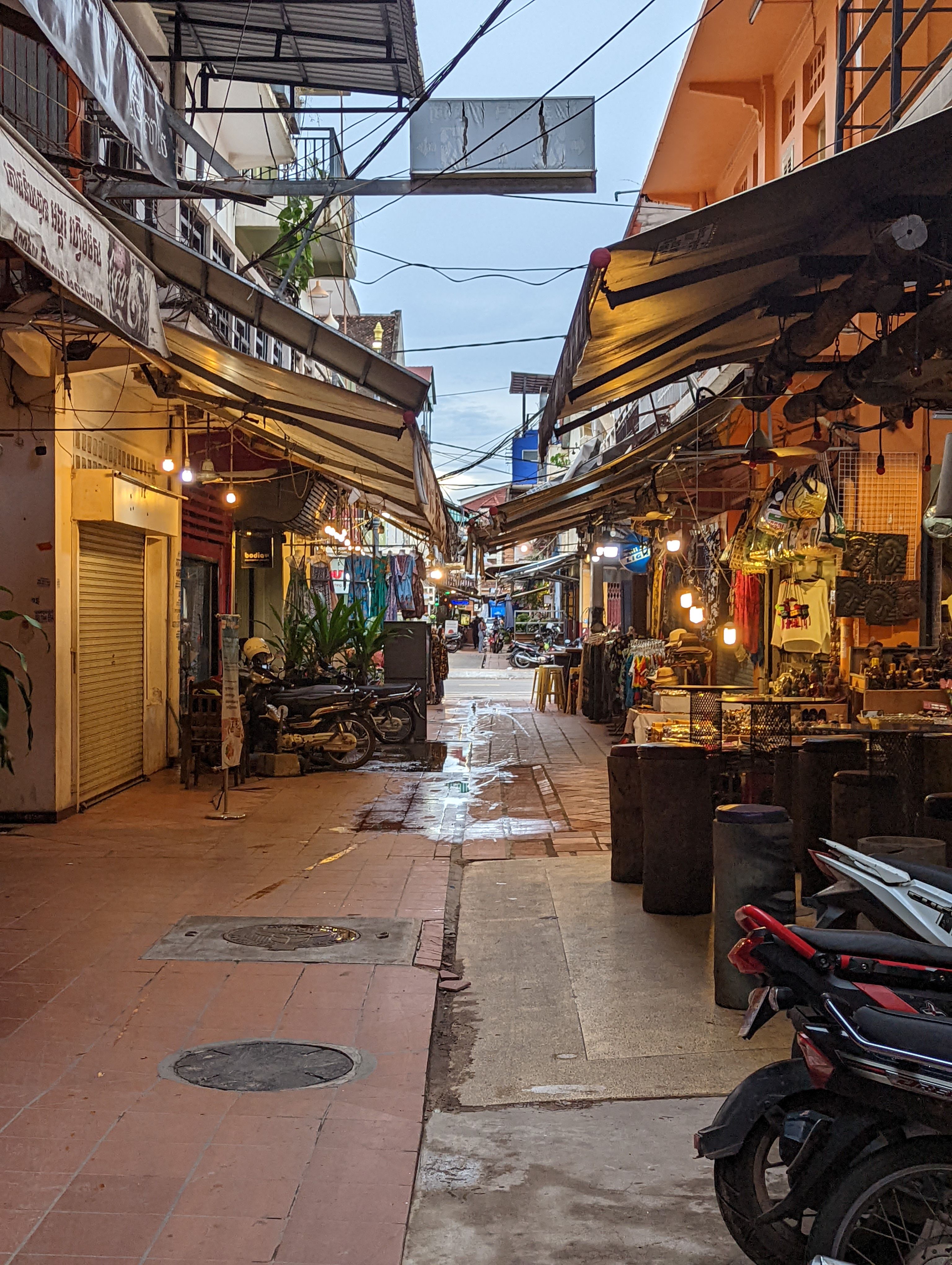 |
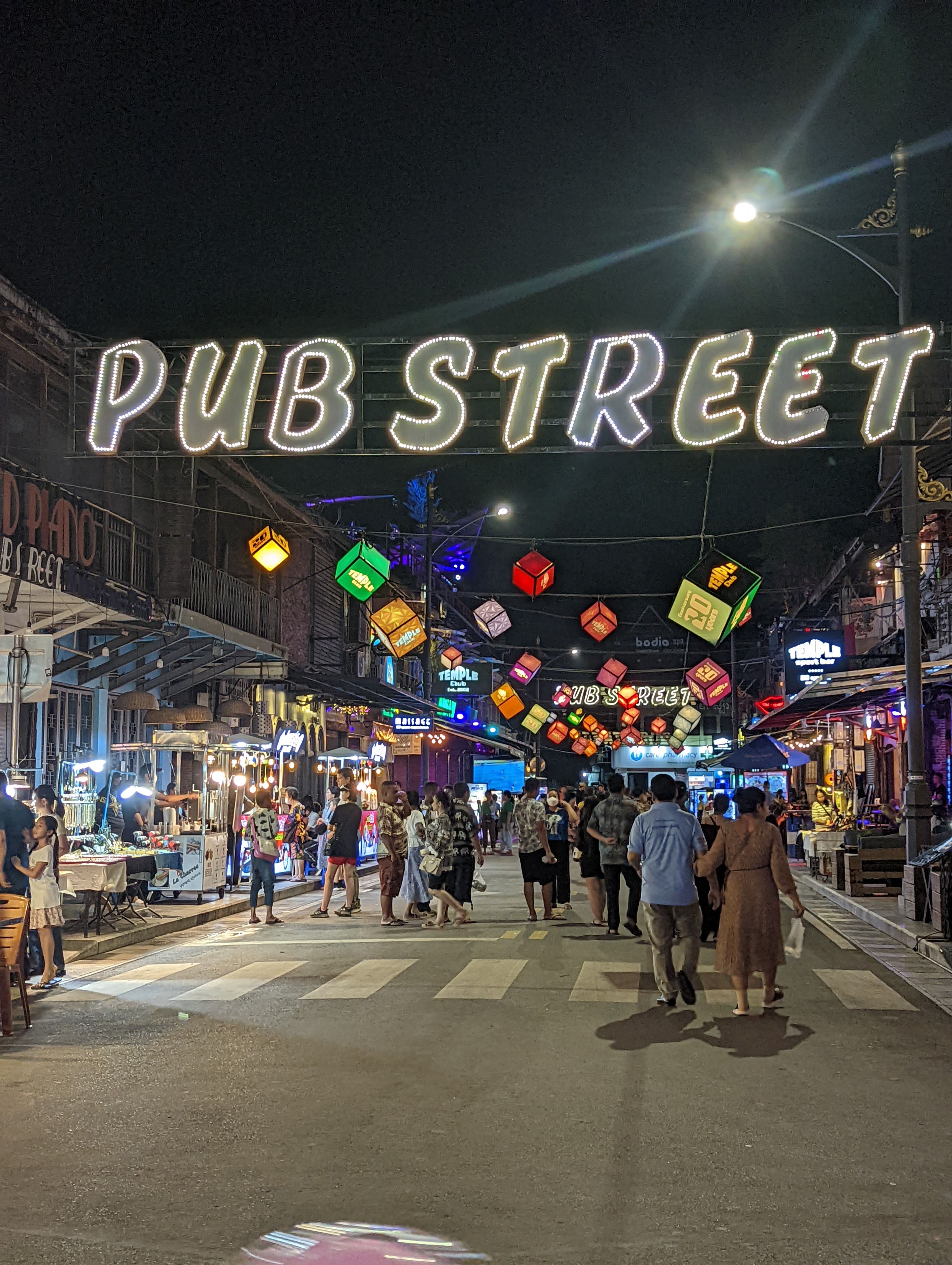 |
Motorbike rental
We had booked this Airbnb months before our arrival and were a bit shocked to see how far away it is from town. We had clearly misjudged the distances on the map. A 30 min walk to the town center wasn’t so bad the first day, but we quickly decided to rent a motorbike for a few days. I was quite shocked at the prices! But haggling is pretty much a must here in Cambodia. We managed to swing the price down to $8 a day. In return we received the shoddiest looking bike the shop had: it almost always failed to start on the first (or second, or third) time, had a broken left mirror, no under-seat storage and a broken spedometer! Oh and it had over 300,000km on it! Still, I have great respect for these little machines. They just seem to keep going.
Renting the motorbike was a great decision, since it allowed to explore the temple complex of Angkor in complete freedom…
A note on driving in Cambodia
Two words: corner cutting.
It’s diabolical. Whether it’s small roads or complex junctions, it’s mayhem. Just go slowly and look in every direction. In some ways the chaos sorts itself out, but you are forced to be part of it, forced to cut corners and wiggle between cars.
Another way to grasp the picture: Cambodia has outlawed driving with your lights on during the day, but there is no law requiring lights during the night!
The Angkor Temple Complex
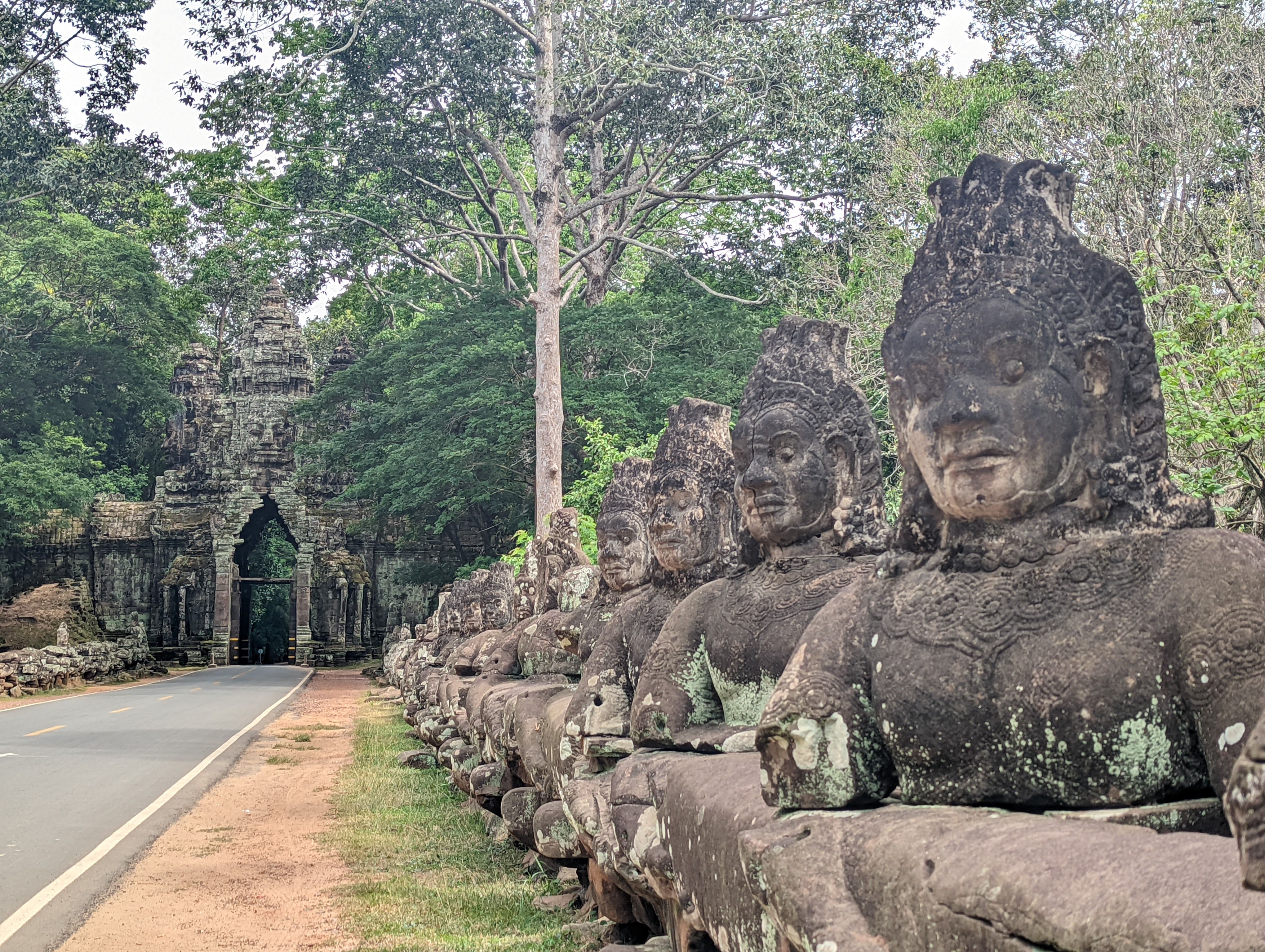 Churning of the Ocean Milk
Churning of the Ocean Milk
This is probably the first place I have visited in my travels that made the words “must see before you die” ring true and loudly.
We planned on saving Angkor Wat for last, since we had read that its magnificence overshadows the other temples. As such we planned to spending the first day exploring the temples inside Angkor Thom, Preah Khan, and Preah Neak Poan.
We rode to the ticket office (which is nowhere near the temples). We weren’t sure if it was the right place as the vast parking lot was virtually empty. This was the first sign that the temples that awaited us will be practically devoid of any tourists.
A 1-day ticket cost $37, but they had a promotion running that let you use the ticket for 2 days, which was perfect for us.
Guide or no guide?
We opted to drive ourselves and not hire a guide, mostly because we had a guidebook and we have been somewhat let down by the guides in Thailand. I will admit though that the guides here, that always seem to be swarming you, sounded like they spoke very fluent and relatively sophisticated English. In these struggling times I did feel bad not hiring their services, but through experience I’ve found that I don’t get much out of it. It’s nice to learn more, yes, but I prefer the tranquility in exploring and immersing yourself in private. A few paragraphs in a guidebook will never be sufficient in describing the history of any place but it allowed us to strike a nice balance between knowledge and independence.
The walled city of Angkor Thom
After a scenic ride along the mostly straight roads, we passed through the South Gate of Angkor Thom, a few turns later arriving at the main entrance of Bayon, the temple of faces. Throughout the temple, countless faces emerge from the stonework, protected by an outer wall meticulously decorated with sprawling bas-reliefs depicting important events of ancient Khmer history and culture. Expecting crowds, we were stunned by the lack of people here. The eerie silence along with the hundreds of faces watching down on you resulted in a mind-bending experience.
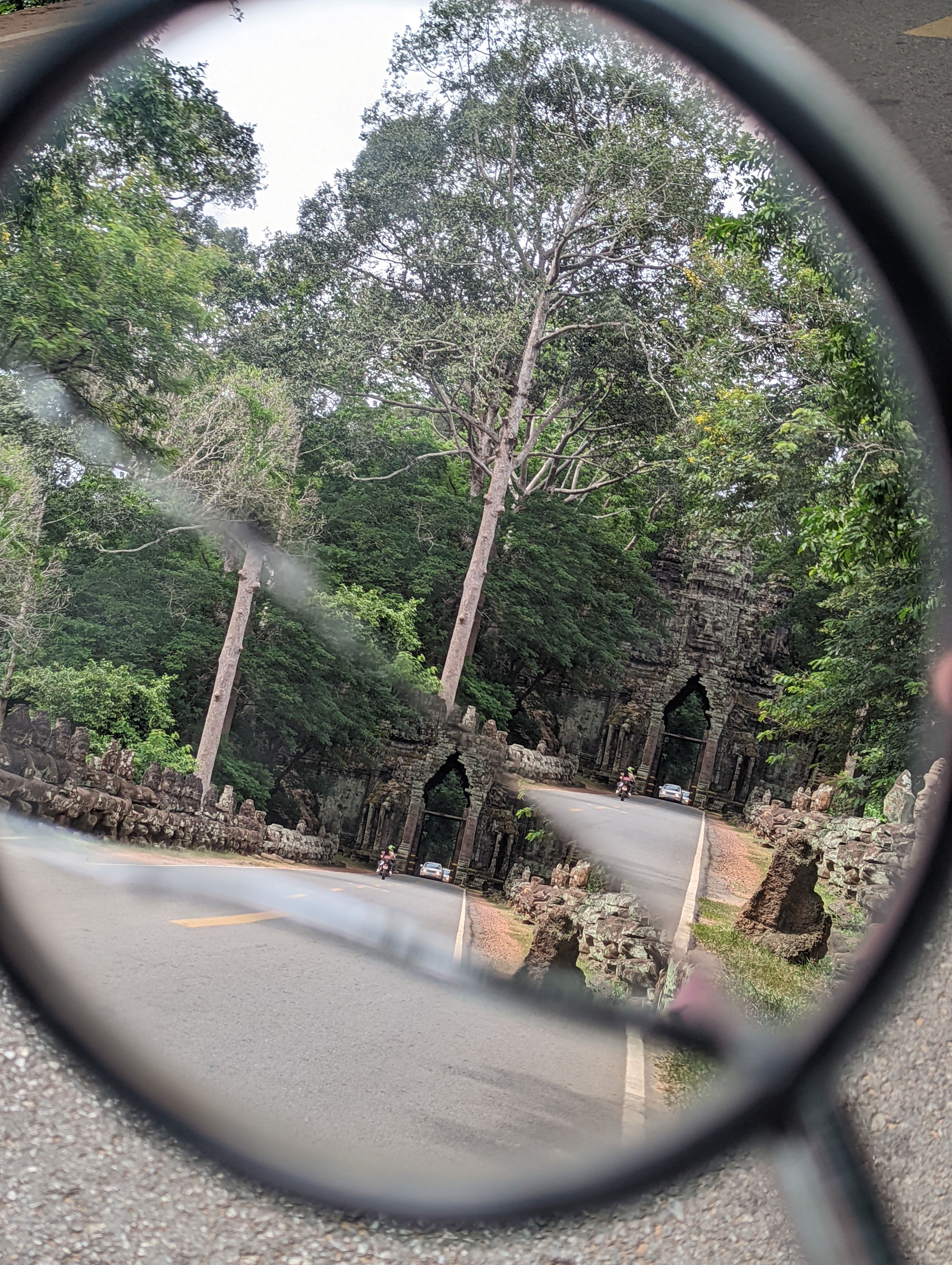 |
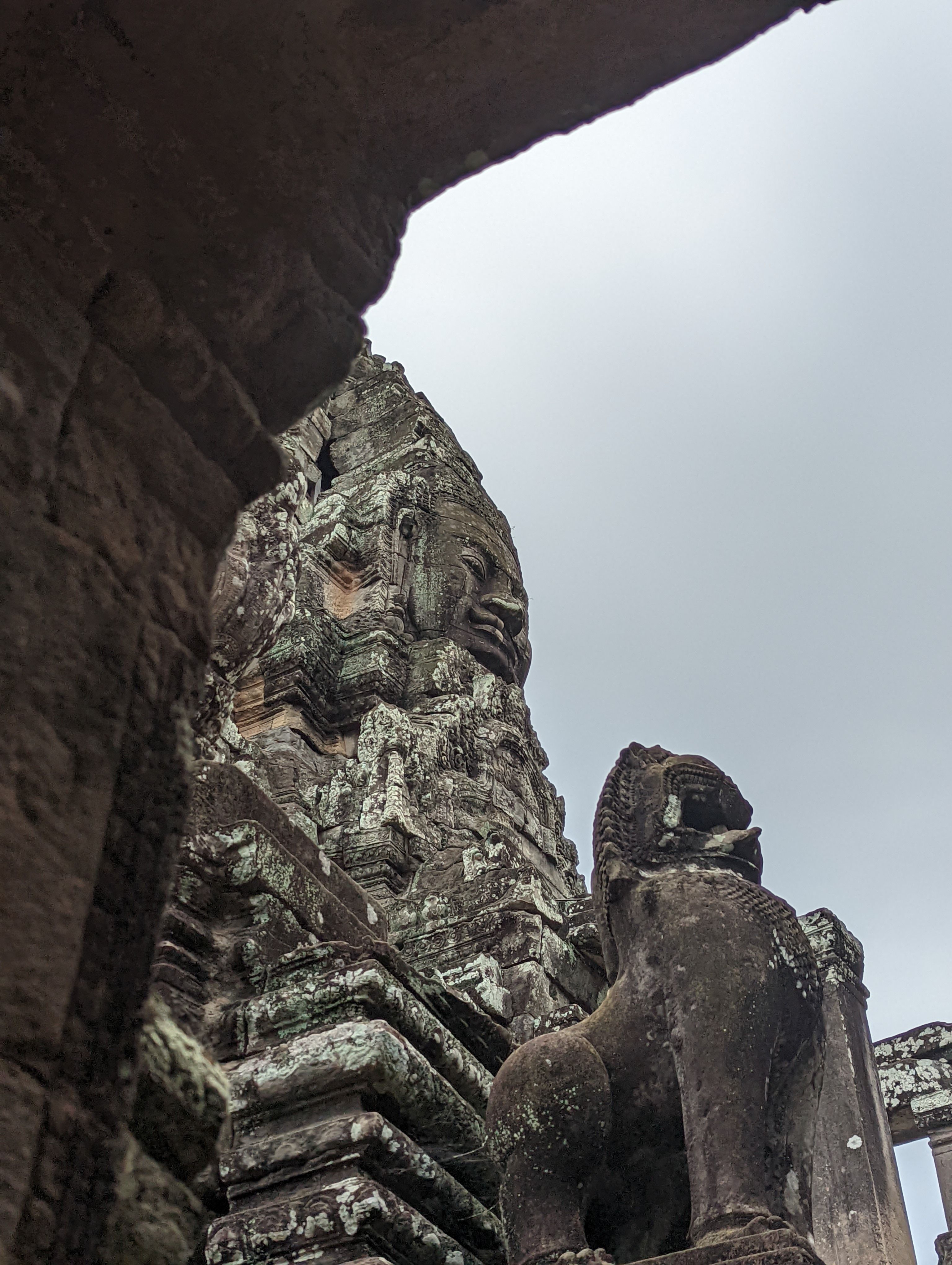 |
Next we drove to Phimeanakas Temple and did the short trail to Baphuon (typically it’s done the other way round). Baphuon was another fantastic experience, seeing as we were mostly alone.
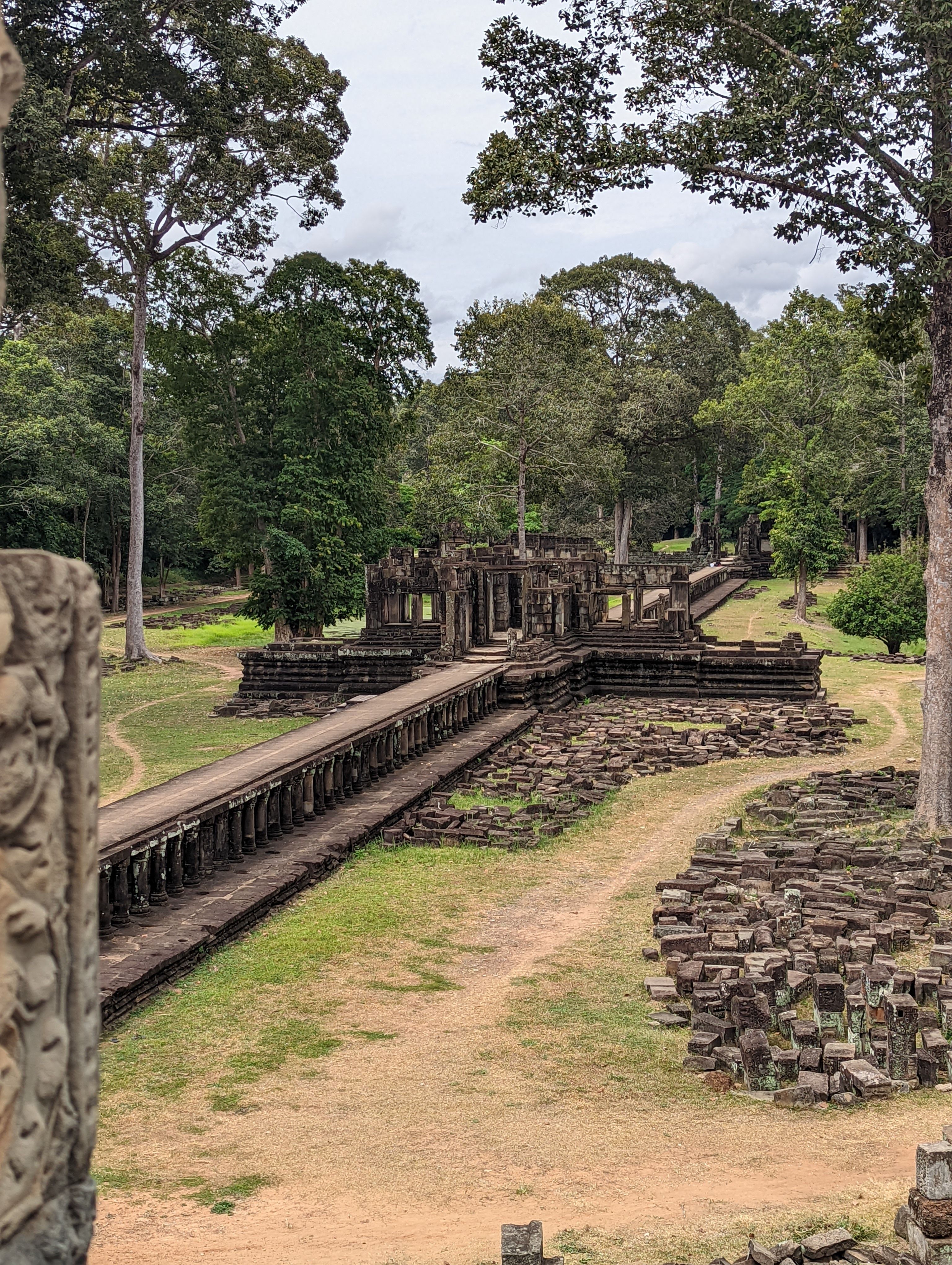 |
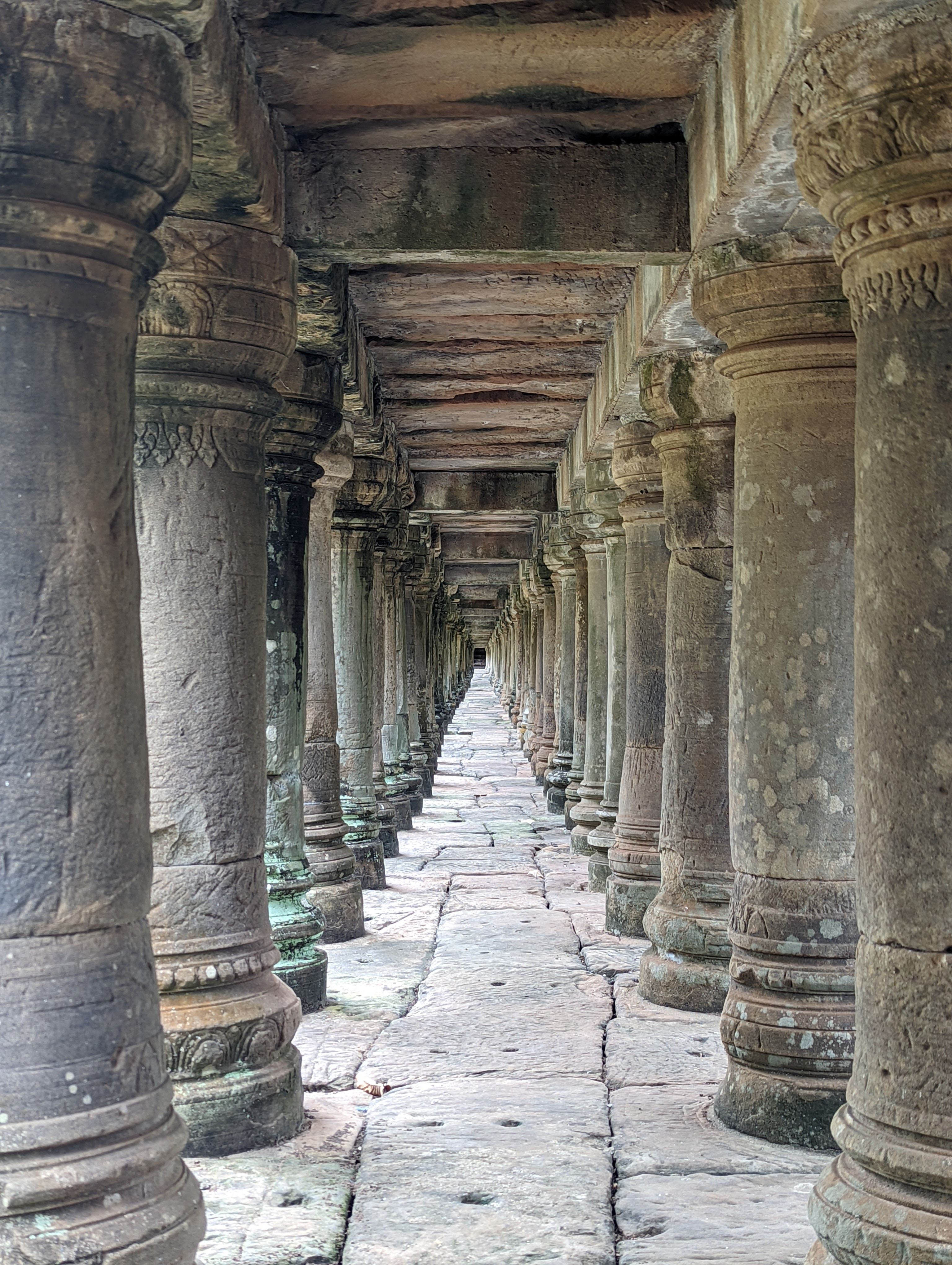 |
Looping back we walked along the Terrace of the Elephants, before hopping on our bike and heading to Preah Khan. A much “flatter” construction, but what it lacks in height it makes up for with its maze-like corridors so perfectly aligned they give the illusion that you’re in a hall of mirrors.
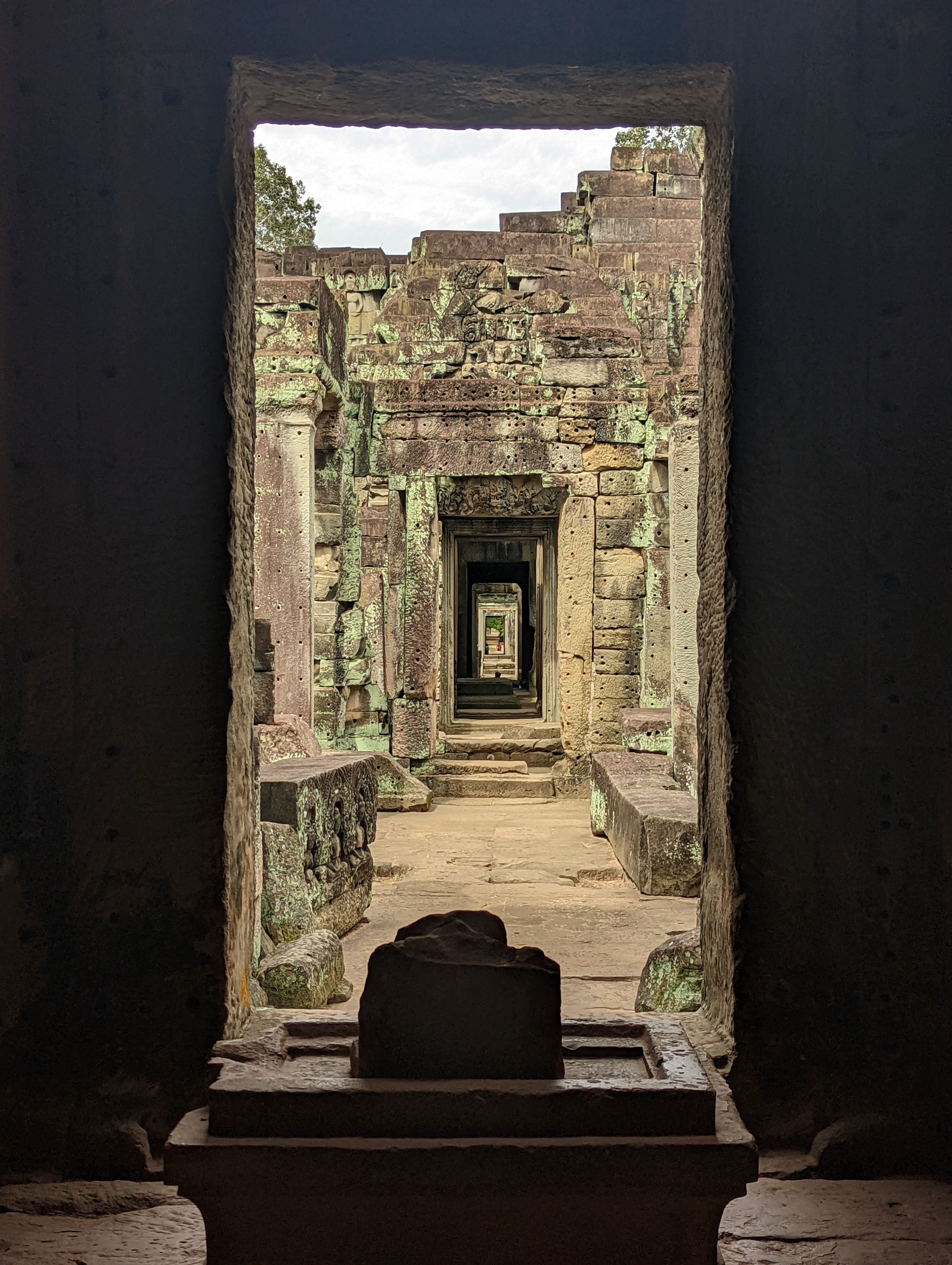
Finally, we rode to Preah Neak Poan. One of the smaller but rather unusual temples, in that it is a simple, small tower that sits in an enclave of moats.
Angkor Wat
We arrived around noon, where the plan was to avoid the morning crowds (that come here for the sunrise) and spend the day exploring the temple, popping over to Ta Prohm and coming back to Angkor Wat for sunset.
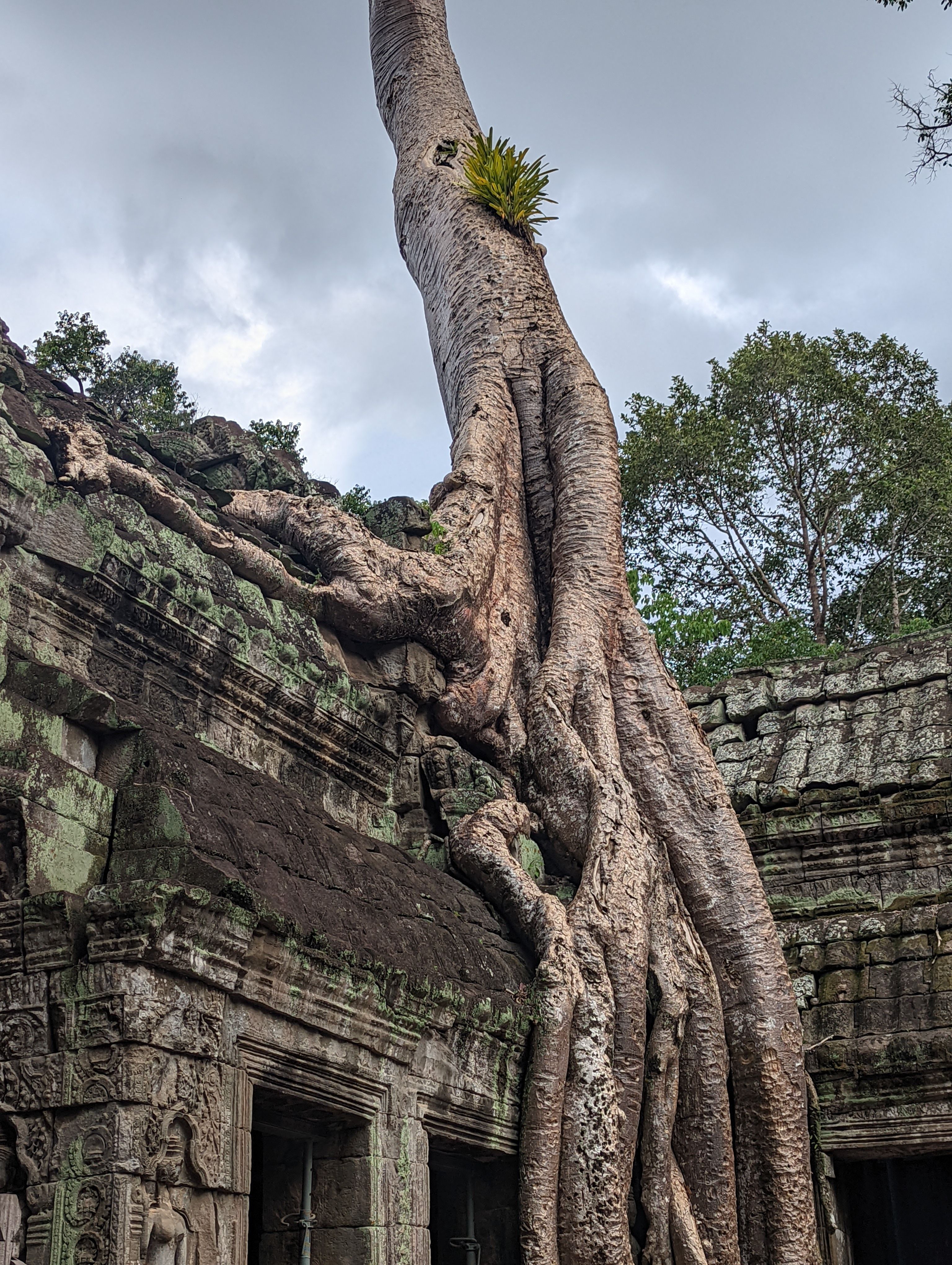 |
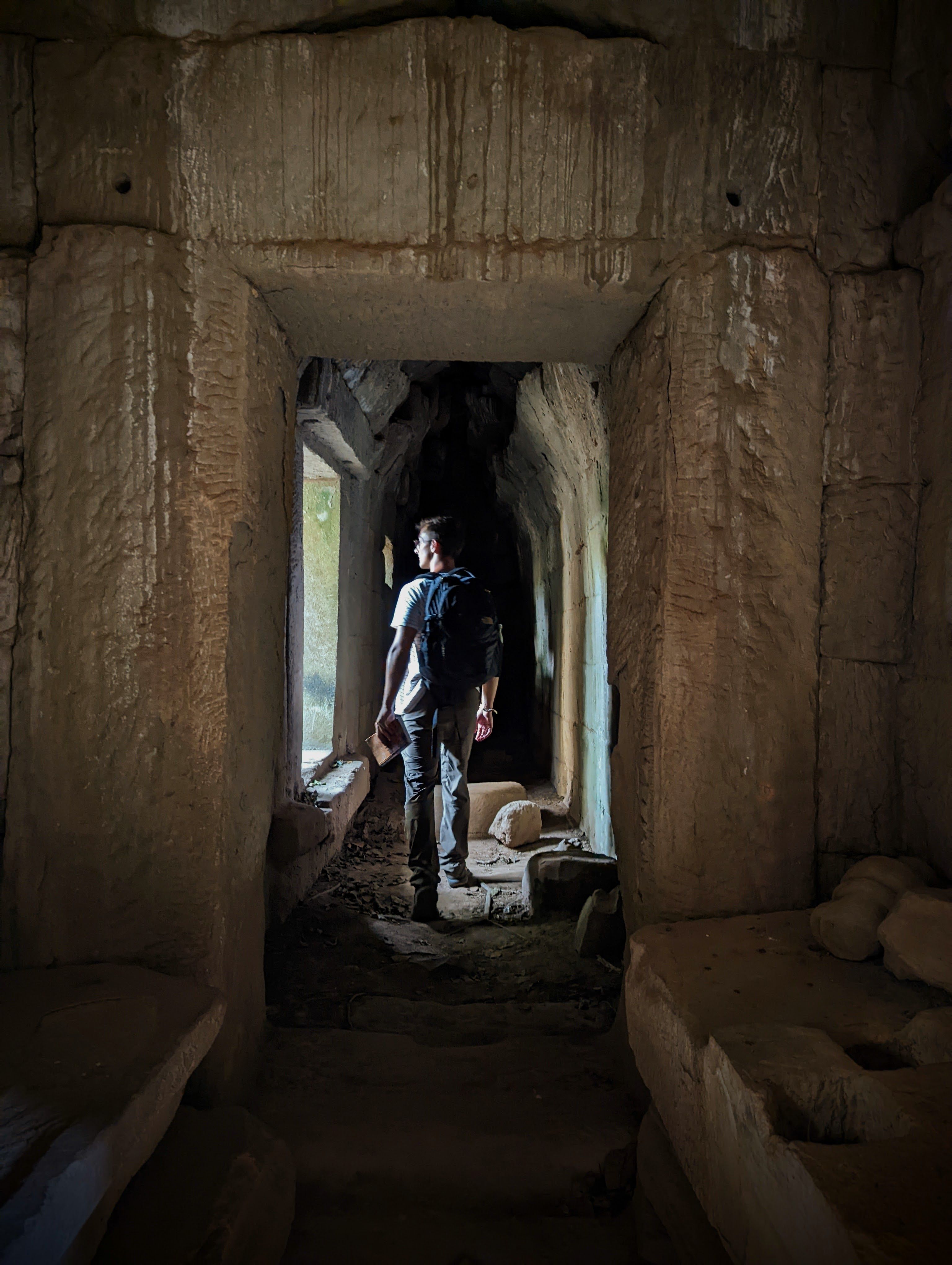 |
There were markedly more people here than the other temples, but most were actually Cambodians. A common thing to do here for locals is to dress up in traditional Khmer clothing and take photos at the temple. It was also a Saturday, so I imagine that it would have been even emptier on a weekday.
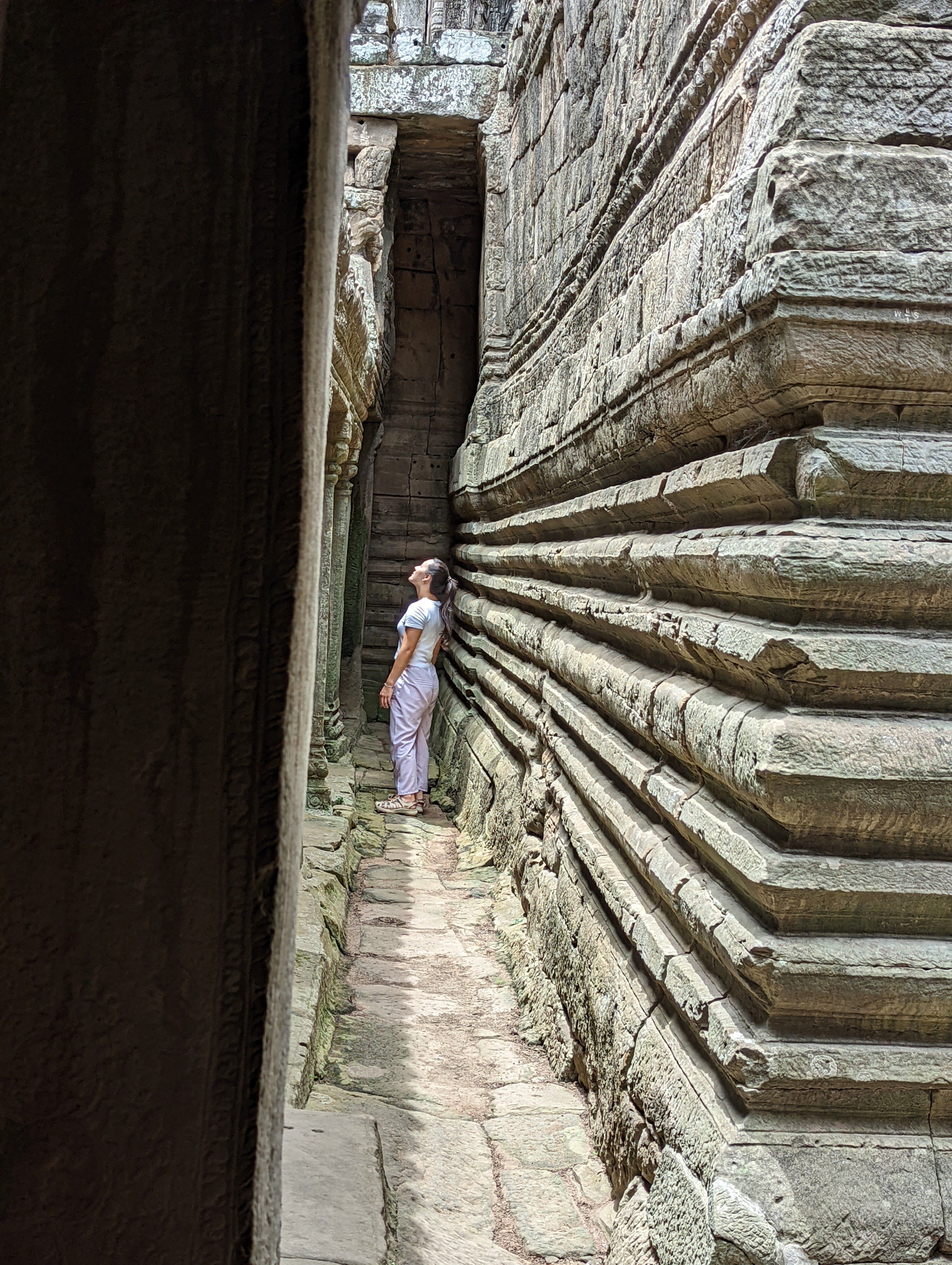 |
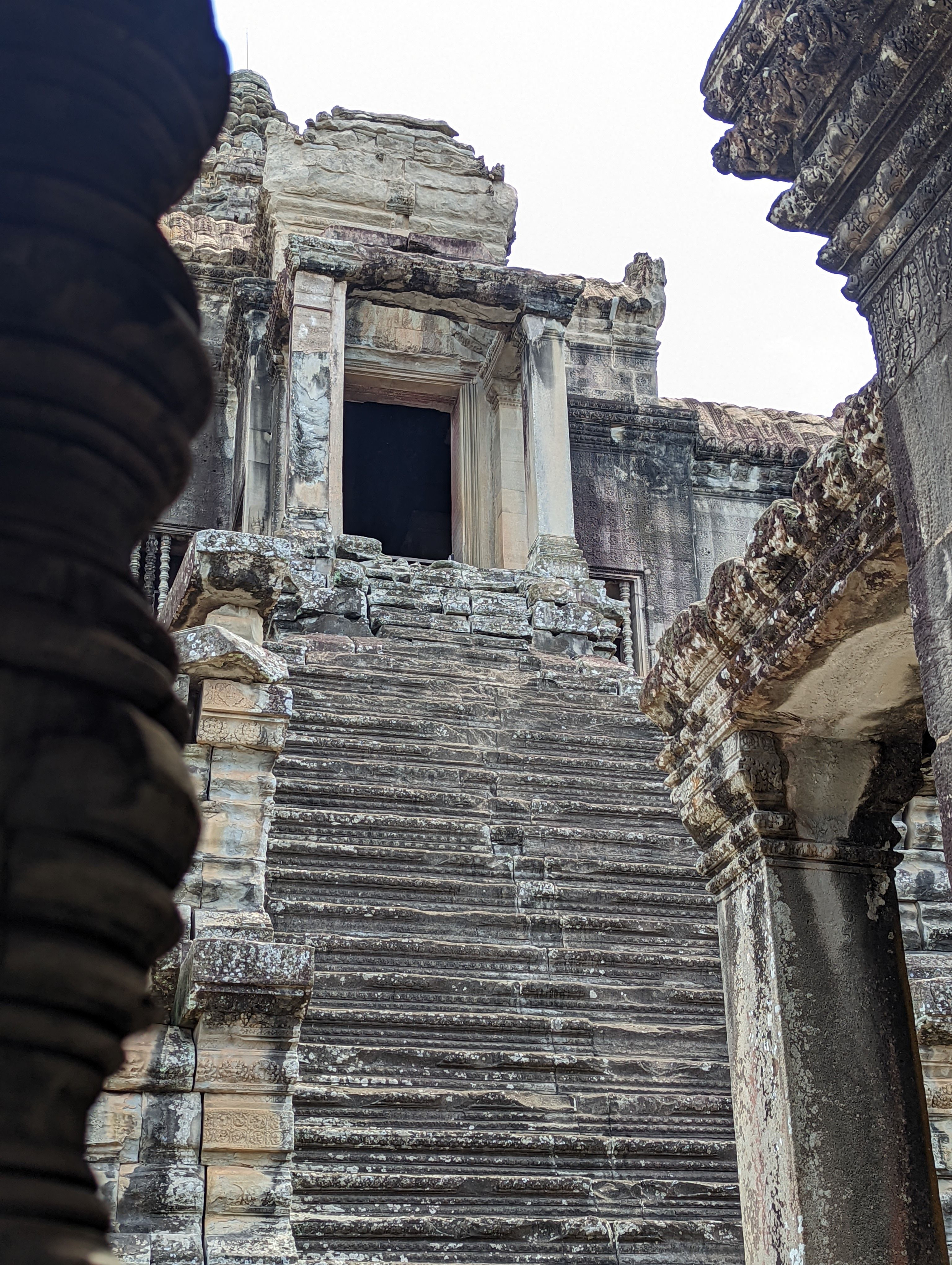 |
Angkor Wat is indeed huge. What makes Khmer architecture beautiful is its excess. An excess that is present both in the decorative sense and embedded into the base structure. Even the small libraries, with an interior no larger than a modern living room, stand on elevated multi-level platforms. Every inch of stone is intricately decorated with Hindu and Buddist carvings, which is made more impressive when you let the size of the temple sink in. Borrowing from the guide book we had, it’s simply “devotion etched in stone”.
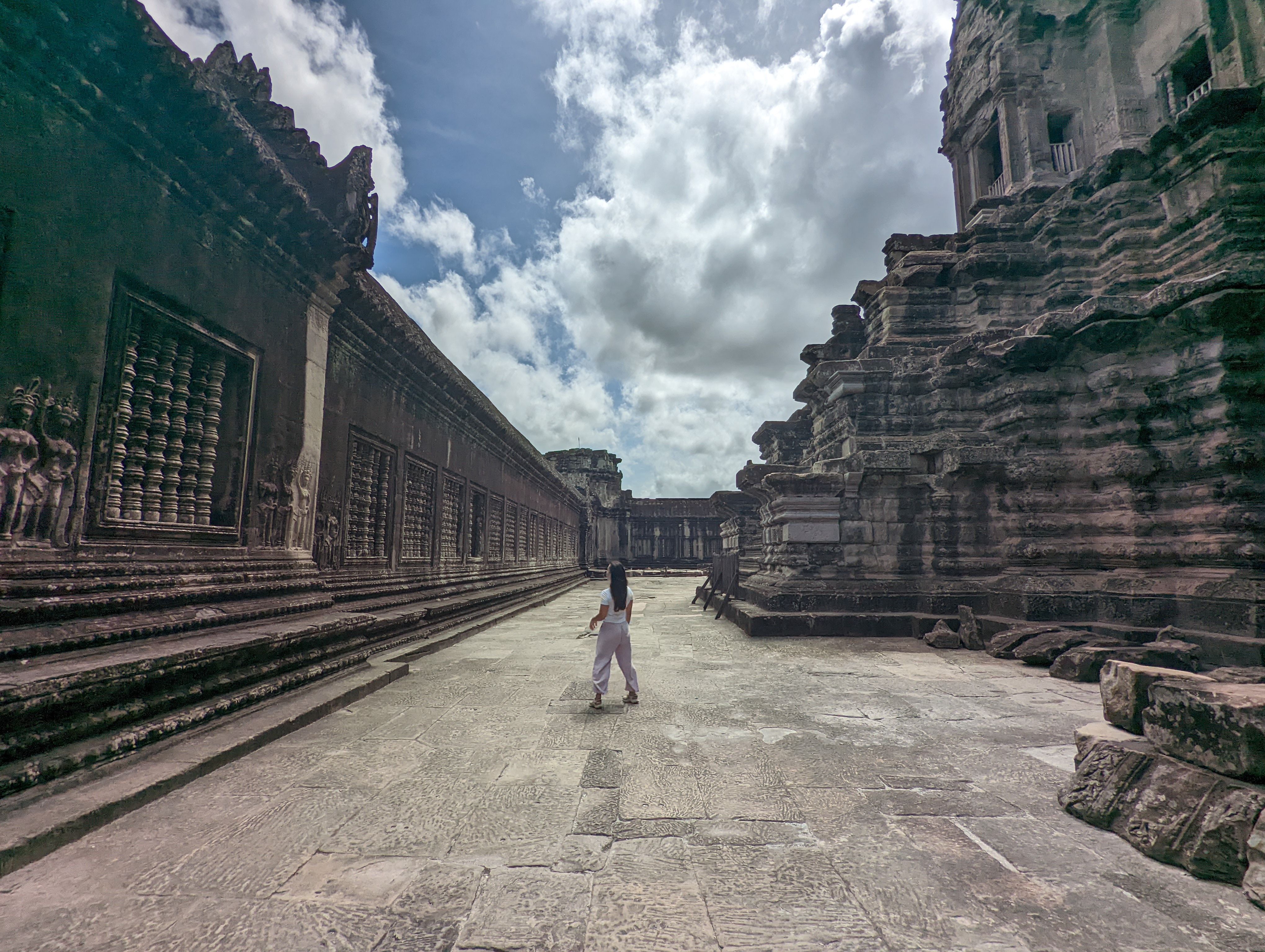
 Monkey, chilling Monkey, chilling |
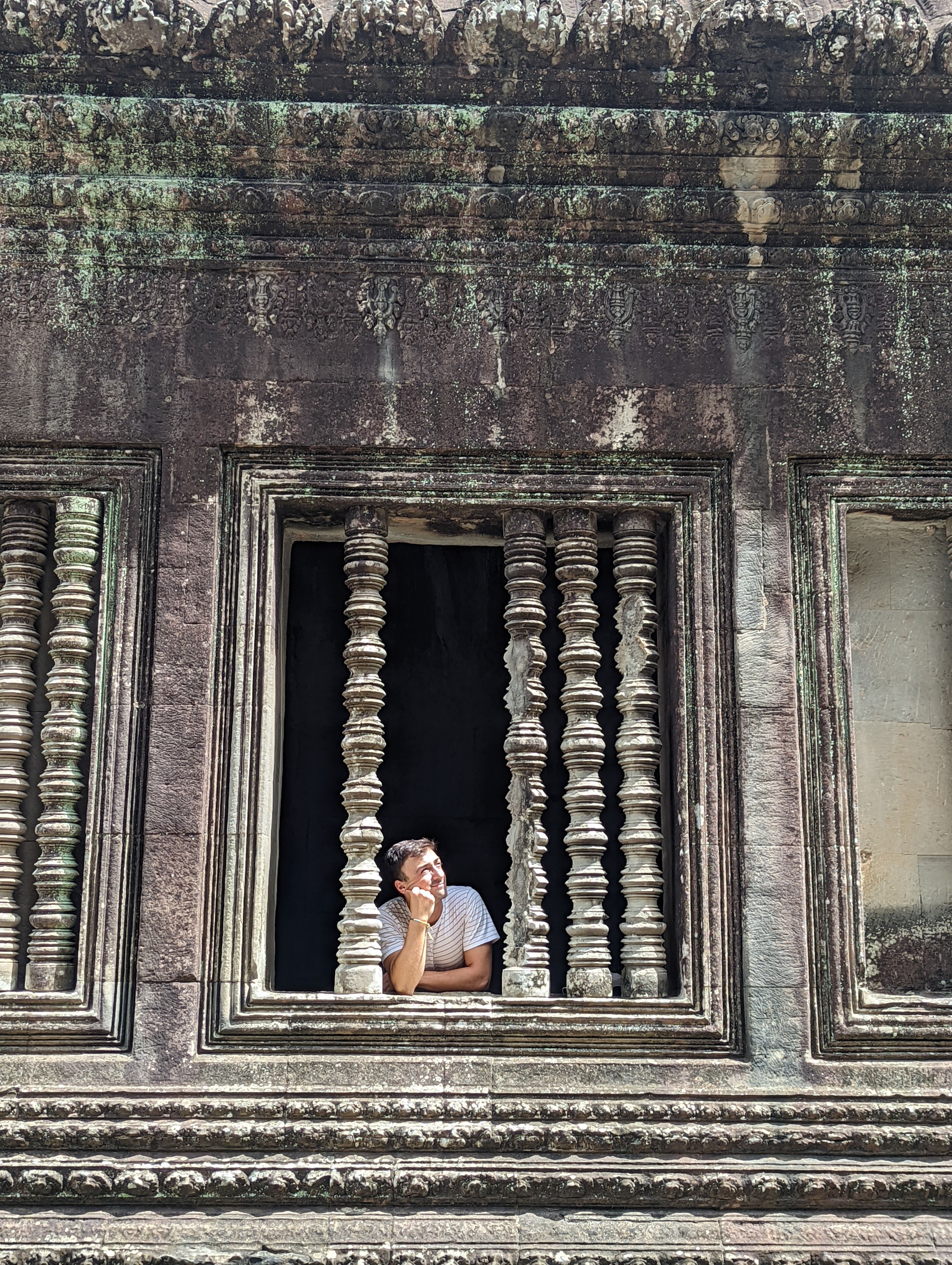 Monkey, admiring Monkey, admiring |
It cannot be overstated how surreal it felt to be there practically alone. We couldn’t understand why but I suppose most of the visitors were busy taking pictures in the courtyard outside the main building. To have this ancient wonder of the world all to ourselves was special.
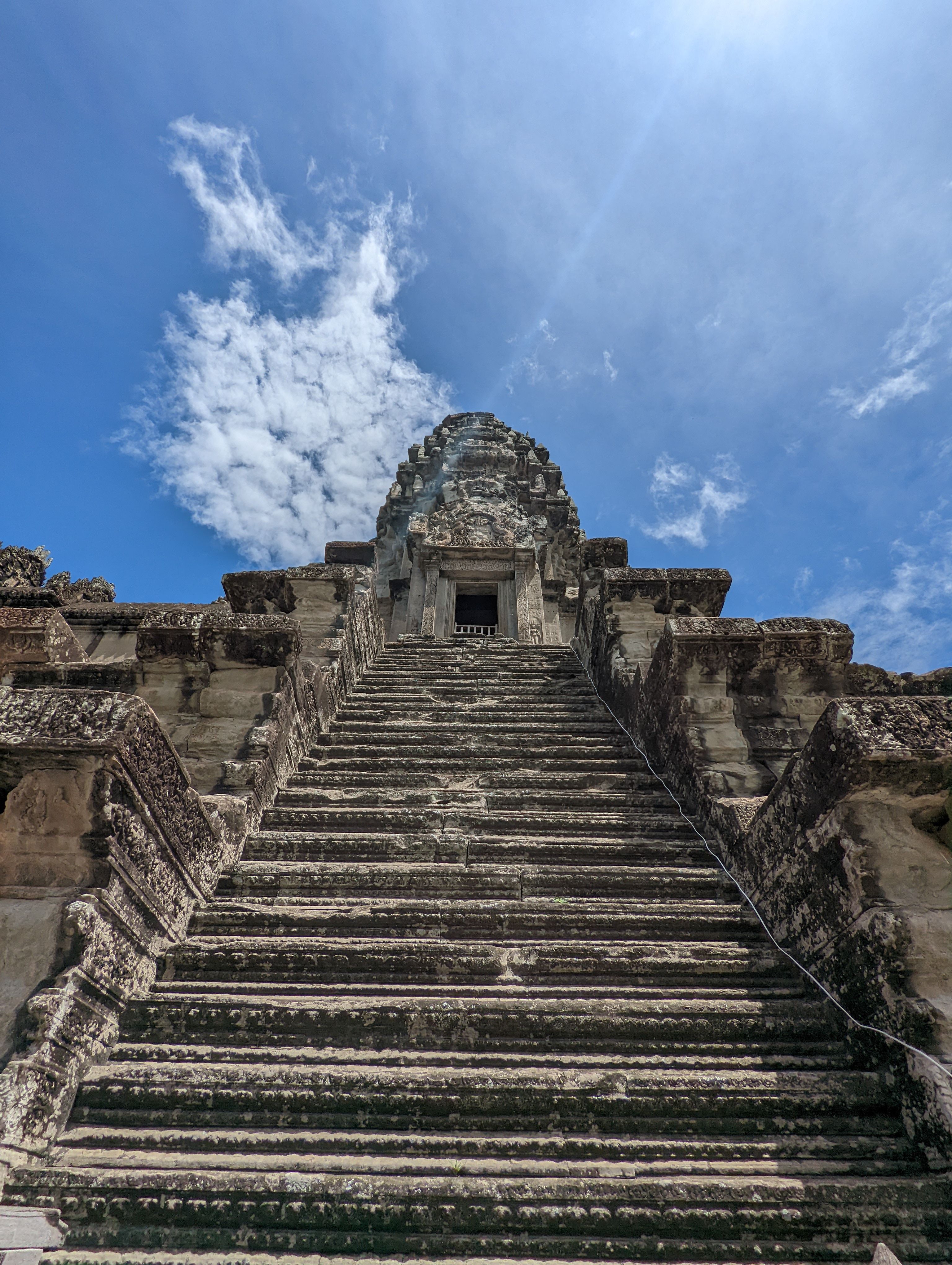 |
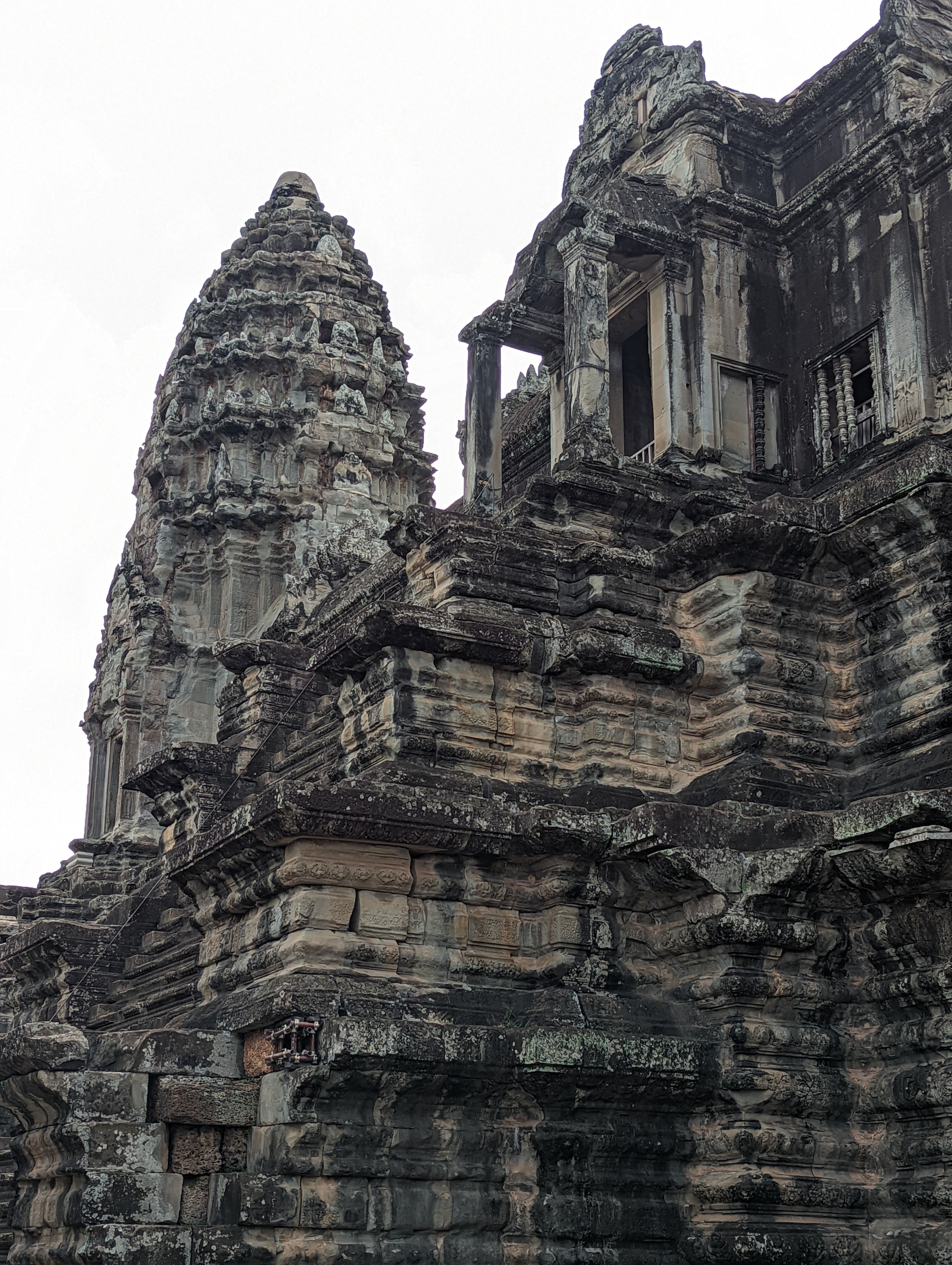 |
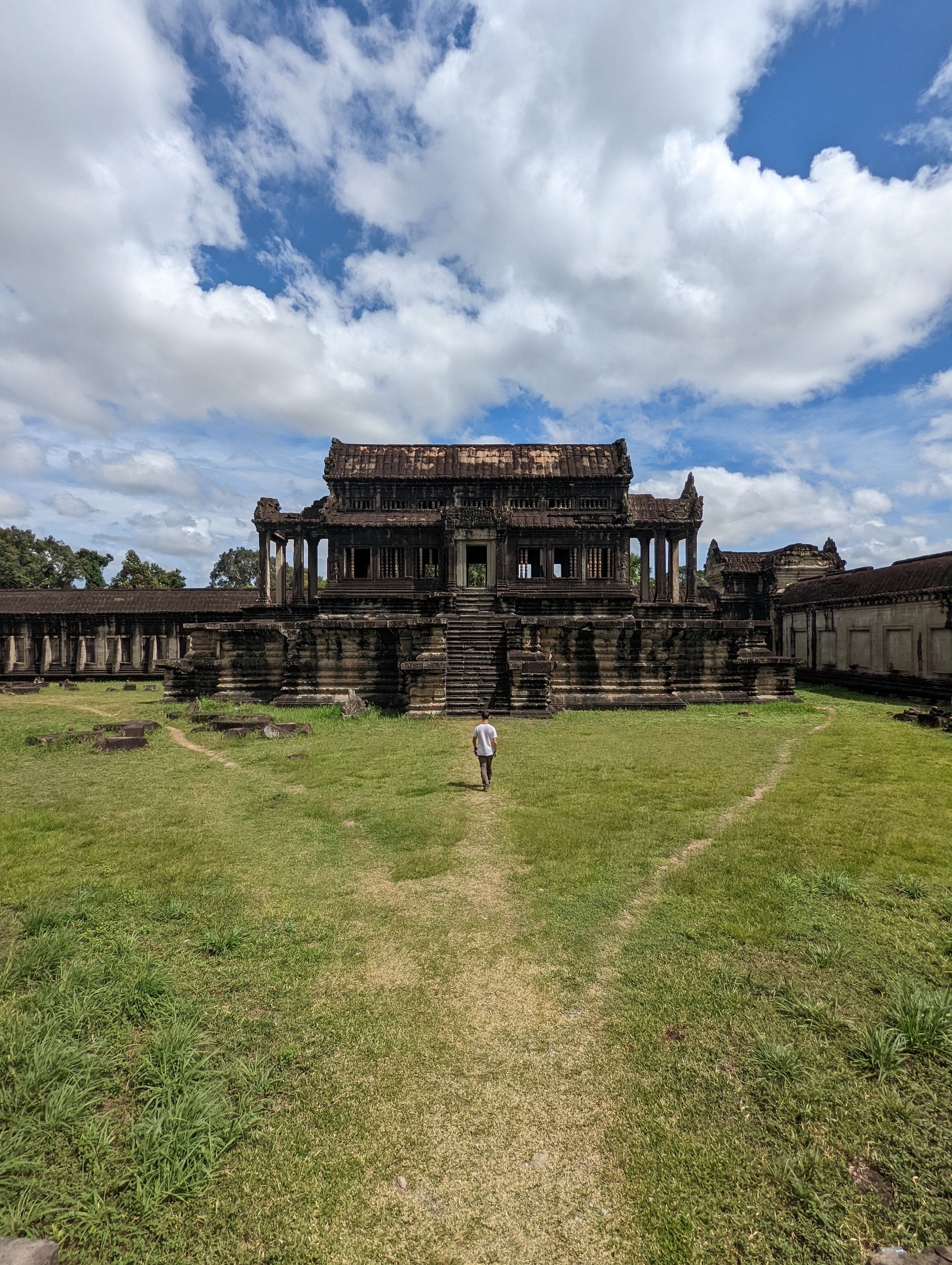 Whilst climbing the stairs of this library, a green snake dropped out of nowhere and “fell with style” down the stairs, much to my confusion.
Whilst climbing the stairs of this library, a green snake dropped out of nowhere and “fell with style” down the stairs, much to my confusion.
I have to admit however that it all somehow felt a bit flat, underwhelming. Every piece of literature speaks, if not shouts, about the grandeur of the temple – when you look at the scale, the quality of the carvings, the architectural and logistical undertaking by the thousands of workers/slaves, all taking place in the 12th century – then it’s easy to understand why this site is considered culturaly and architecturaly monumental.
To explain the cognitive dissonance here, I think it’s because of something counter-intuitive: restoration and conservation.
Though the other temples in the complex have recieved some attention, they look and feel much older (and some are in fact older). Some, like Ta Prohm, have been engulfed by the jungle, giving them the romanticised look of ancient ruins that I expected. To put it simply, Angkor Wat has been preserved and restored so well that it takes a departure from common expecations, or at least, my own.

This is not to say that we weren’t appreciative of the exprience. I don’t say this lightly: you must see this place before you die.
Koh Rong
Cambodia is not as beach-rich as Thailand, but we had read good things about the islands of Rong and Rong Samloem. We had also read, and heard, one too many disparaging antectodes about Sihanoukville so we planned on just skipping that town completely. That meant getting a night bus that drops you off at the Sihanoukville port and then getting a boat to Koh Rong almost immediately.
The Night(mare) Bus
Pre-COVID the bus schedule was probably a lot richer; we only had the option of a night bus at 20:00 or luxury night bus at 20:30. What made it luxury? The presence of a toilet. I wish I was joking.
Half excited, half terrified at the prospect of beds on a bus, I kept my expectations low and I was still disappointed. The booking website didn’t bother to explain that beds are in a bunk, where the lower bunk is basically on the floor, level with the gangway, and has zero lights. You are given a thin slit by the window that only served to make the bunk feel even more like a bunker. But to its credit, there was a power socket on the roof and an AC that couldn’t be turned off, so I taped it off, seeing as the millimeter thin blankets didn’t do much. At 169cm I just about fit the length of the bed.
In all honesty, the surroundings weren’t that much of an issue. What made it uncomfortable was the maniac driver, who must’ve thought that luxury means rally and bus means 4WD WRC fitted a fuel-injection turbocharged engine with an air intake restrictor. At times I thought the bus is about to tip over. At times I felt like we’ve genuinely gone off-road. Though seeing the state of some of roads we must’ve driven on at a later date, off-road wouldn’t be a terrible description.
The island
This was once a much loved destination for tourists, but the pandemic has ravaged the brittle tourist economy here. As soon as we arrived the place felt dead. We felt dead, if I am being honest, having gotten close to zero sleep and then endured a sea-sickness inducing boat ride to the island.
We were somewhat prepared for this. Booking our stay here was painful, because the island only caters to hostel-loving partygoers or those willing to drop a small fortune for a week’s stay at a mediocre resort. Nothing in between. We honestly felt pretty ripped off paying $25 a night for a smelly, dirty, damp room. But what we found was the best compromise. A few dollars less will only net you a shared dorm or a shack disguised as a bungalow. Double that price and you’d maybe get an okay resort.
 |
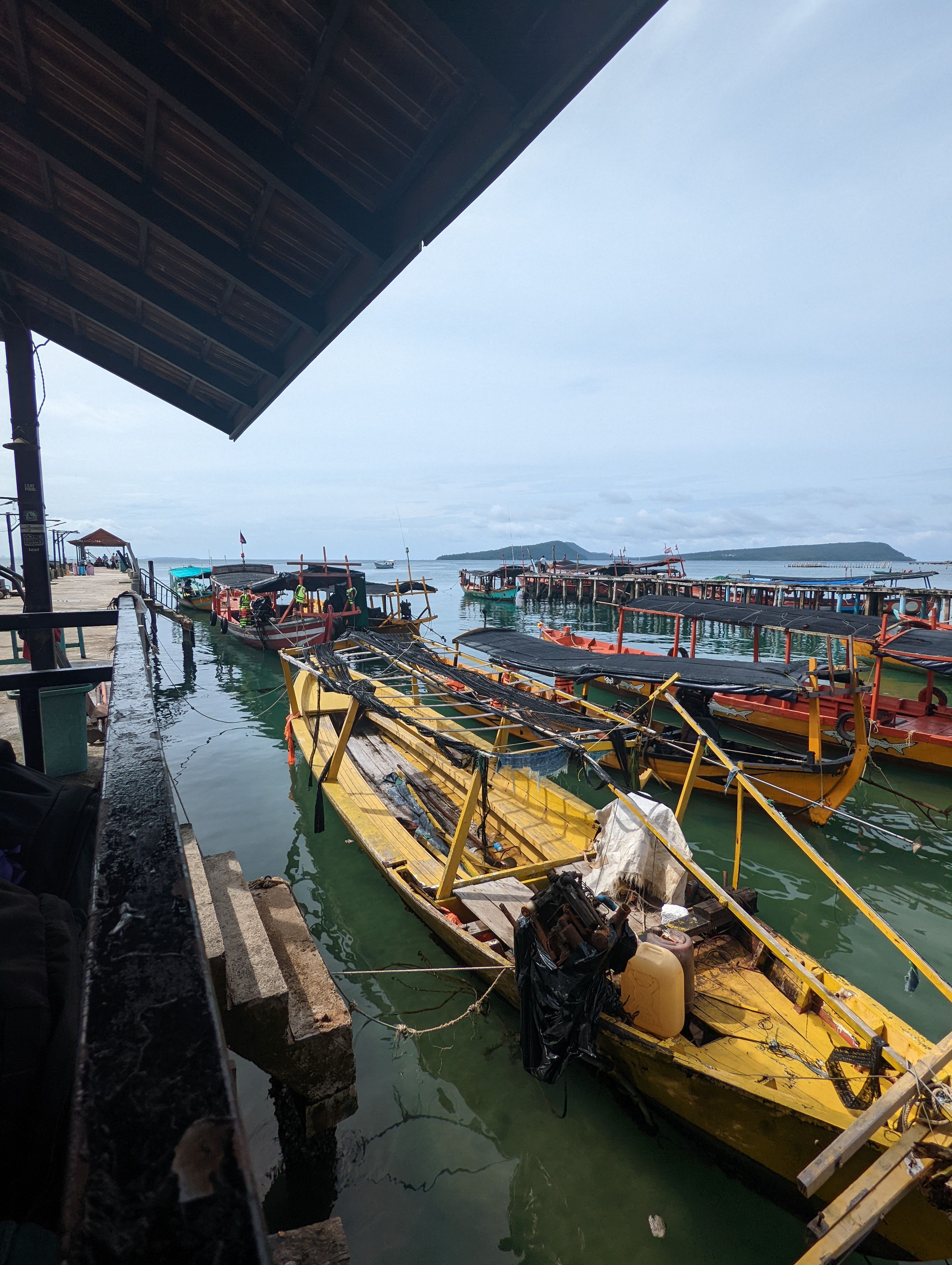 |
What I’m saying is that no matter the price, your expecations would not have been met. We genuinely don’t ask for much, we don’t look for luxury; so long as it’s clean and private we’ll be happy. I fully understand that these businesses are barely staying alive and keeping the prices high helps these families live. Perhaps it was cheaper pre-pandemic. Perhaps not. I’m aware that islands tend to be more expensive, but having had just spent a month in Thailand, where the quality was much higher and the prices were lower, we couldn’t help but feel swindled and unwelcomed. I suspect that countries with less developed tourist-economies need to charge more until development improves, tourist numbers rise, allowing prices to go down.
The beach itself was decent. The strip at Touch beach is now the most bustling part of the island (according to the locals). A short walk through the frog filled forest along the shoreline took us to Long Set beach where Nest Beach Club was the only nucleus of life around these parts.
Those frogs are incredibly loud during the night and they are venomous! 🐸
We had only booked 2 nights, and I am glad we did that because we weren’t really enjoying ourselves. There was little to no atmosphere here and pretty much nothing to do. We questioned whether we’re not giving the island a chance, but after discussing it with each other we realised we’re not going to feel good staying any longer in that dank room and we wouldn’t feel good paying extra for the quality that we saw after shopping around for different accomodation.
It felt good getting off that island, as much as it pains me to say that.
Kampot
Buses to Kampot on the regular ticket websites were not be found, so we had to pay extra for a shuttle. At $12.50 it wasn’t the worst deal in the world. Despite leaving 30 minutes earlier than scheduled, we arrived in Kampot in the late afternoon because the driver seemed to be doing half the town’s delivery chores.
 |
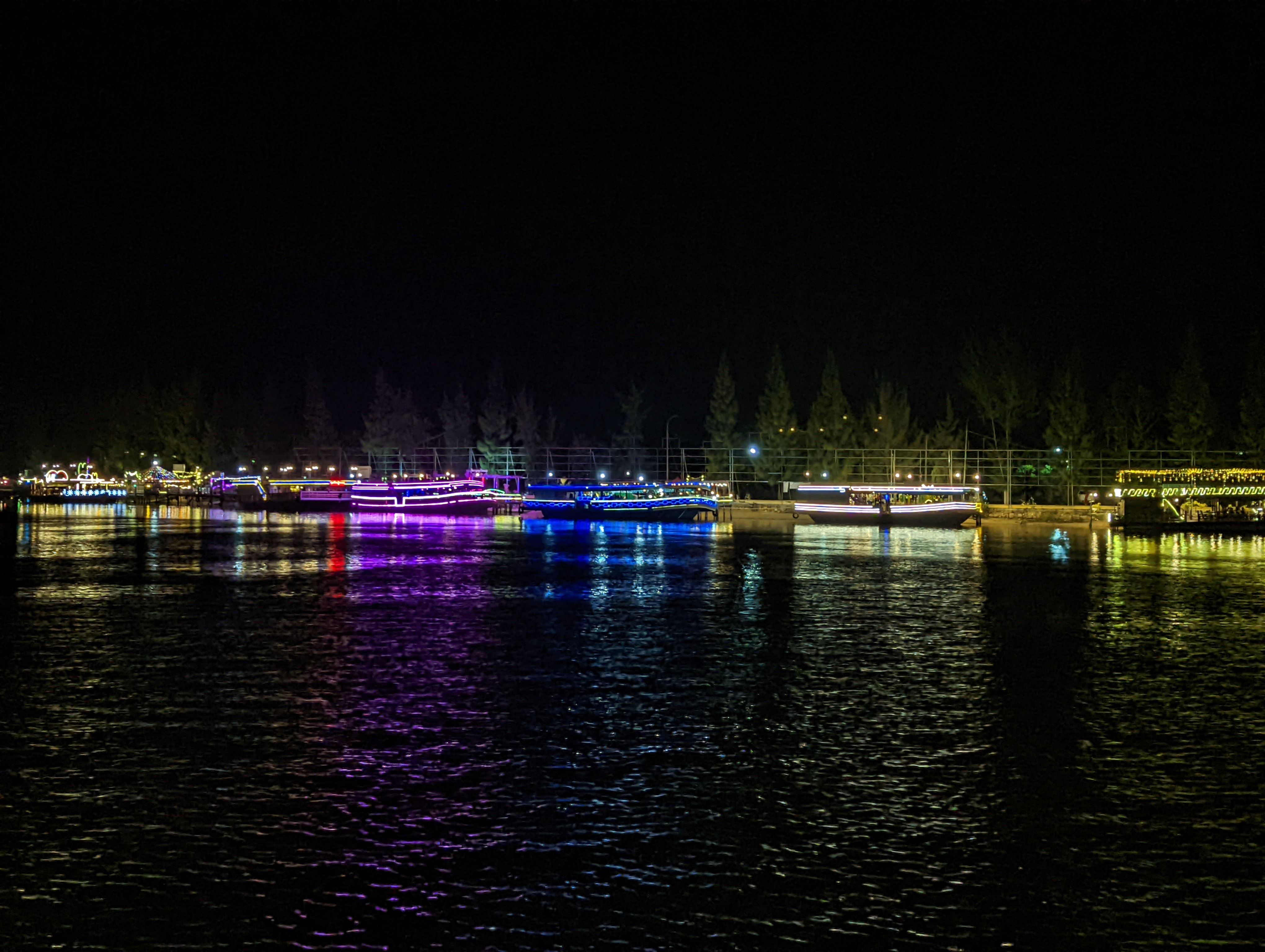 |
Kampot was nice. It was to Phnom Penh what Chiang Mai is to Bangkok; a smaller, quieter town with a charm that you can’t quite put your finger on. Likely it’s the old French colonial buildings that are left on one side of the river, now hosting a small collection of restaurants and bars.
One thing that stood out here was the rather large and unexpected community of elderly Americans. Primarly single men; at least I assume they were single as they were always by themselves at the bars and restaurants. I think there exist some unfavourable connotations with this… scenario, which I won’t go into, but I will say that a pretty large drunk man that fit the above description crashed his bike right next to us whilst we were having dinner. He was okay.
I expected a few more markets in Kampot and a few more things to do. The river boats are a nice option at night, but once again I think the town was marred by the slow post-pandemic recovery and generally low season.
Bokor National Park
We did enjoy renting a bike here and driving around the Bokor National Park. It’s a lovely ride up to the view point(s), the road twisting left and right with a gentle upwards slope. On the way we saw numerous packs of monkeys, with some pretty large individuals strolling across the road. We also saw an enormous Great Hornbill flying over in the distance whilst admiring the view of the first viewpoint.
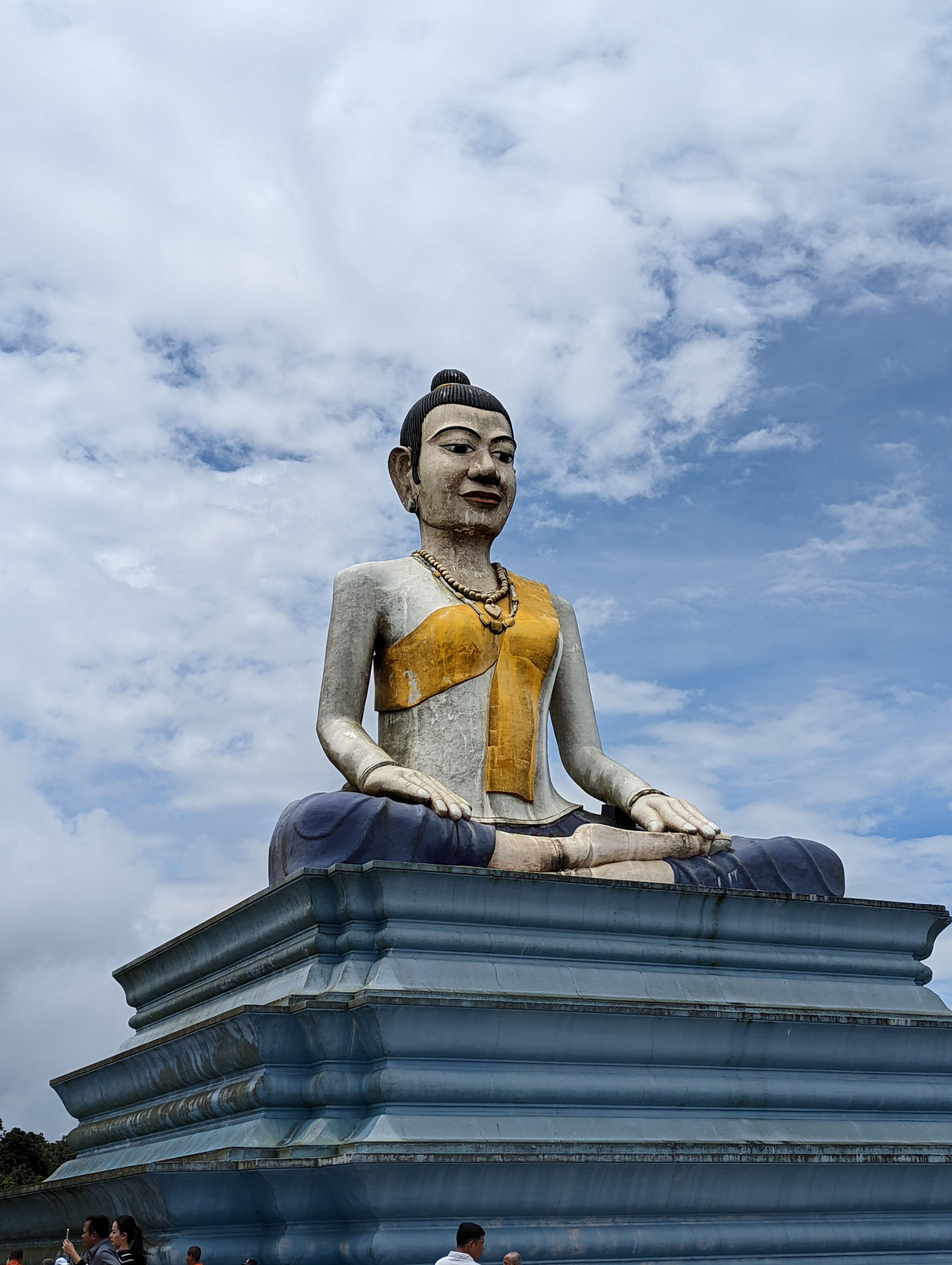 |
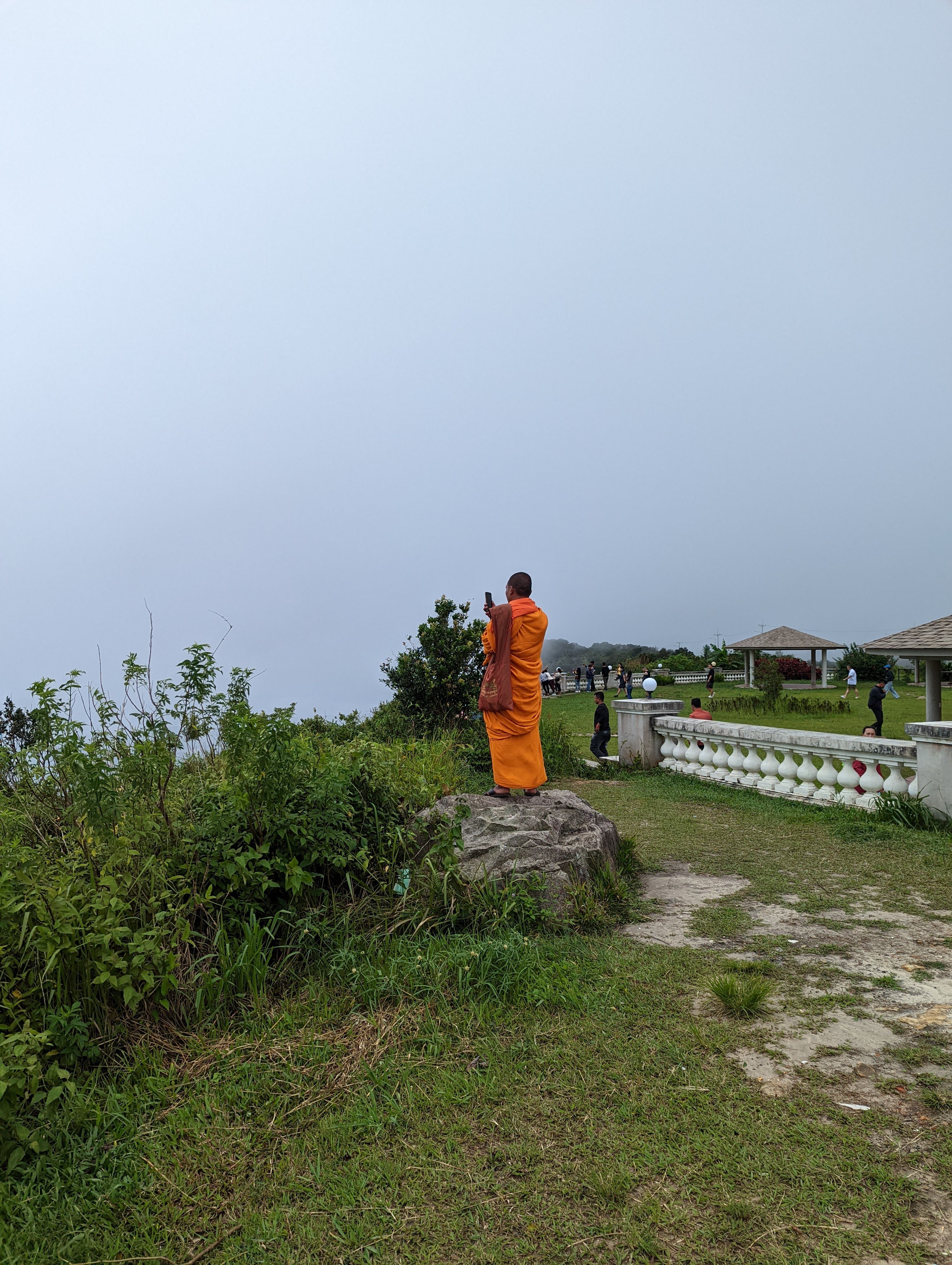 |
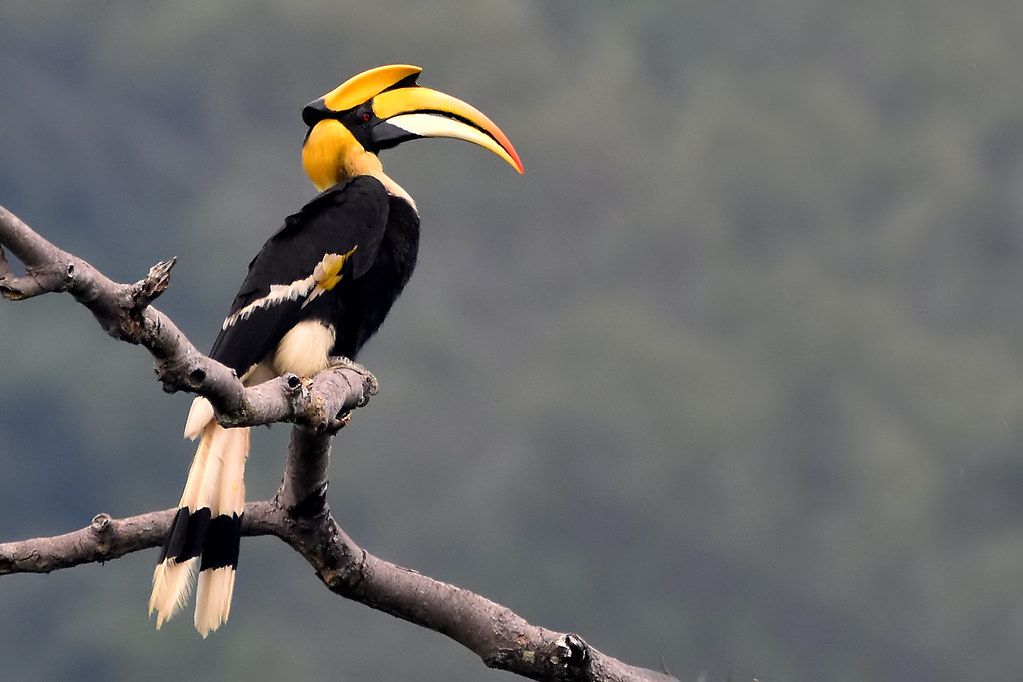 We didn’t see it as close as this image depicts it but I had to include an example. (Source)
We didn’t see it as close as this image depicts it but I had to include an example. (Source)
The roads there took us through a number of abandoned buildings which were made eerier by the frequent fog rolling over the hills. We came across a giant abandoned-looking but very much alive hotel, the Thansur Sokha. We needed to use the toilet so we took that as an opportunity to go inside: it was very grand! Quite strange to find it amongst so many desolate and forgotten projects.
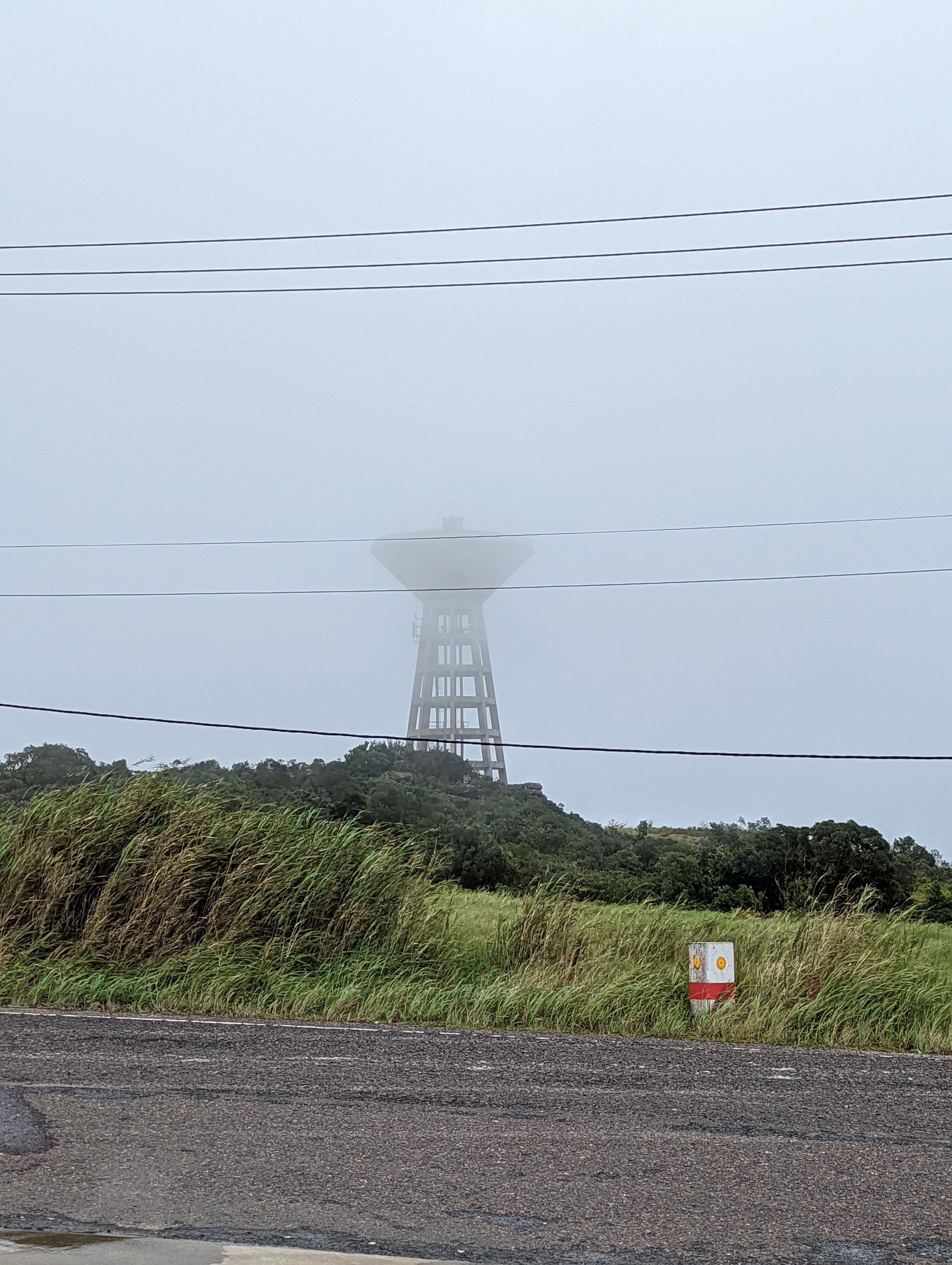 |
 |
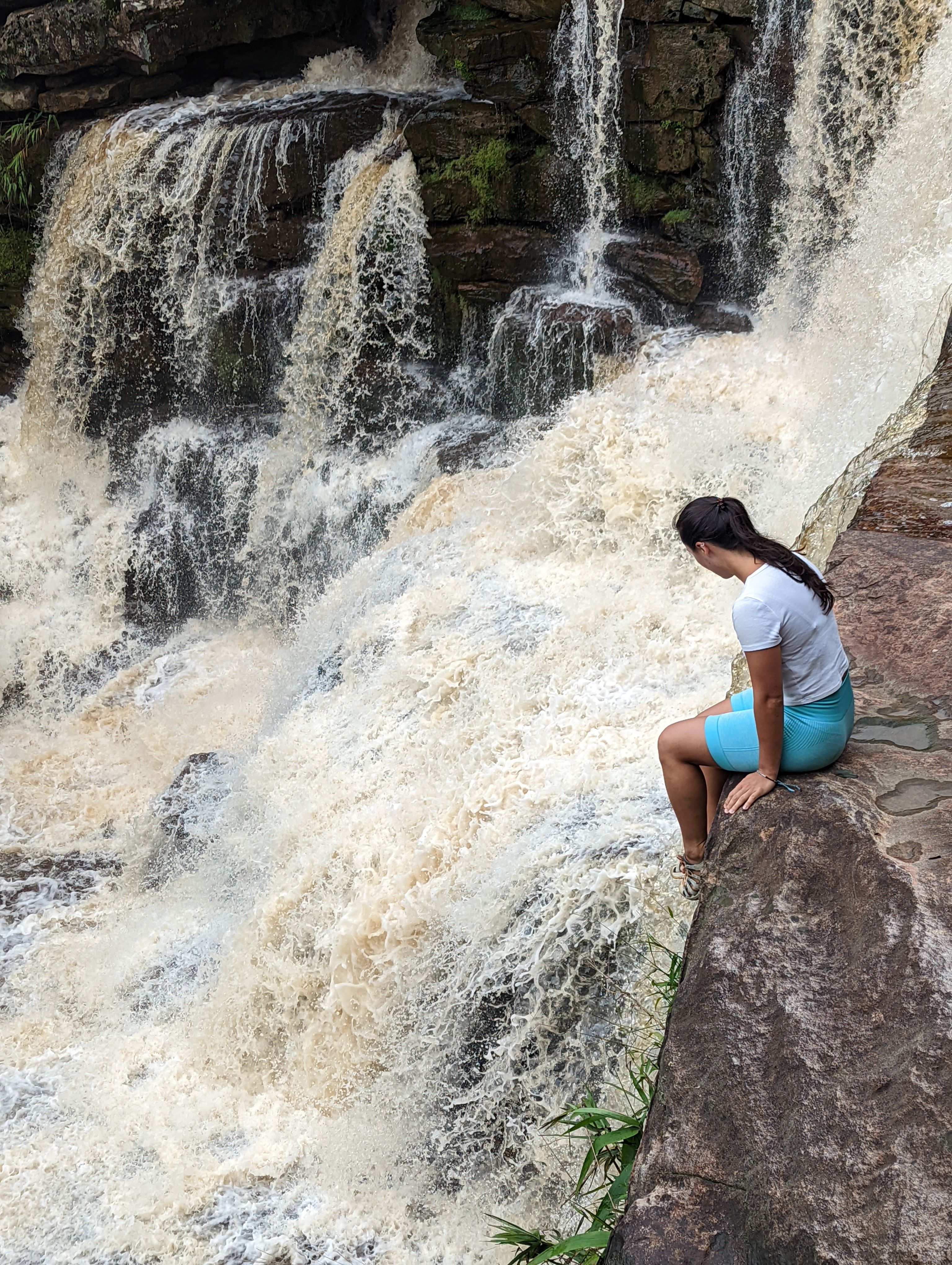
La Plantation Pepper Farm
Kampot is supposedly famous for its pepper and not having all that much else to do we figured it would be interesting to visit one of the farms. We had also wanted to do a cooking class this whole time so when we found out that they did one we booked it pretty quickly.
Weirdly, you had to drive yourself there. It was a fun 45 min drive through rural-ish Cambodia: the road was unpaved and it had been raining heavily the night before which resulted in an abundance of wet potholes. Zig-zagging in an effort to avoid them was a fun challenge.
 |
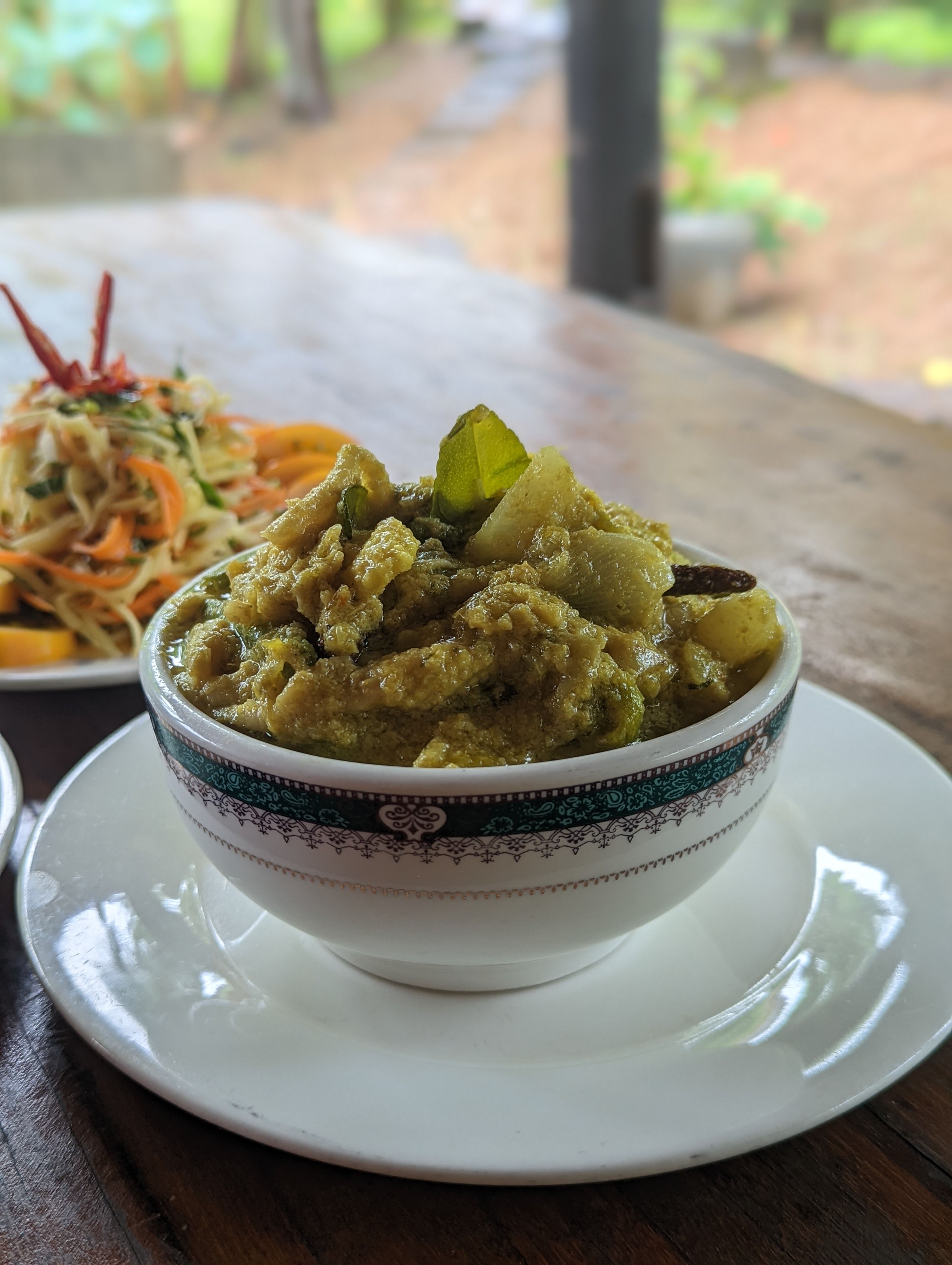 |
The plantation is well maintained and looked after. It’s been there for quite some time and the two owners, a French and Belgian couple, do a lot of work to support the local school and people.
Typically the cooking class is booked fully but luck once again was on our side and we were the only ones in the morning slot. That meant we got through everything a lot quicker. I think the class was aimed at people who don’t tend to cook – not that I am some Michelin level chef – but everything was pretty simple: peel, chop, mash, put it in a pot. I was hoping to learn something new but even the banana bowls for the fish amok we made were pre-prepared. I was also surprised that we didn’t prepare a single peppery dish, like traditional Lok Lak. Instead we made a green curry, fish amok and green mango salad. It was still a good experience and it was nice to sit down and enjoy what we cooked in the plantation’s large restaurant overlooking the fields.
After that there is a short, free guided tour of the plantation as well as a taste testing session. All the peppercorns you can imagine. My favourites were the green (fresh) pepper, that almost pops open inside your mouth, and the red pepper. The smoked and salted varieties were also delicious.
Phnom Penh
Our journey to Phnom Penh began with the bus company having overbooked the shuttle, which meant we had to be uncomfortably squished for a couple of hours until some of the other passangers got off early.
We arrived at our hotel in the afternoon, dropped our bags off and went straight to the curry house opposite for a filling meal.
We weren’t sure what to expect of Phnom Penh apart from knowing that we probably don’t want to spend more than 3 days here. It’s an extremely un-walkable city, with a lot of streets lacking a pavement completely. Despite being a big dirty capital city it didn’t feel all that bad, I must admit. I had expected it to feel like Bangkok in some ways, but it’s way less built up. Nonetheless, 2-3 days is plenty.
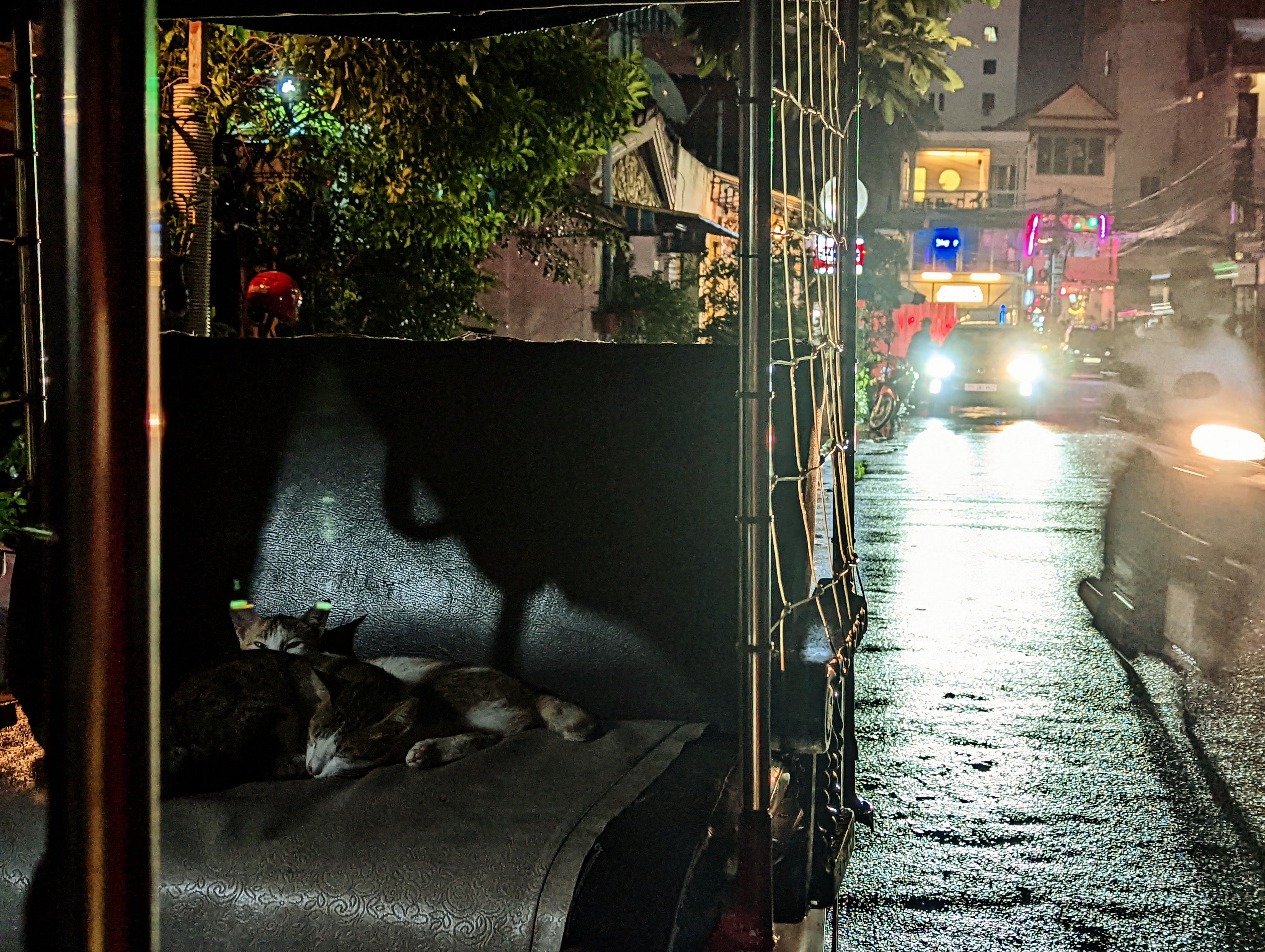 Sorry for disturbing you little kitties, but you were too cute to ignore
Sorry for disturbing you little kitties, but you were too cute to ignore
Street 240 and Bassac Lane in particular had some great bars and lively atmosphere. In general, Phnom Penh actually has a rich collection of restaurants and cafes, different cuisines and price ranges. The Russian market was jammed full of things and reminded me a bit of the visual cacophony experienced at Chatuchak market in Bangkok. Walking through other, less touristy markets was interesting: we got to see where the locals do their grocery shopping. We were actually a bit jealous of all the fresh produce they have access to! Raw fish and meat hanging on hooks, splayed on tables, draining in baskets, it’s all there to see and smell.
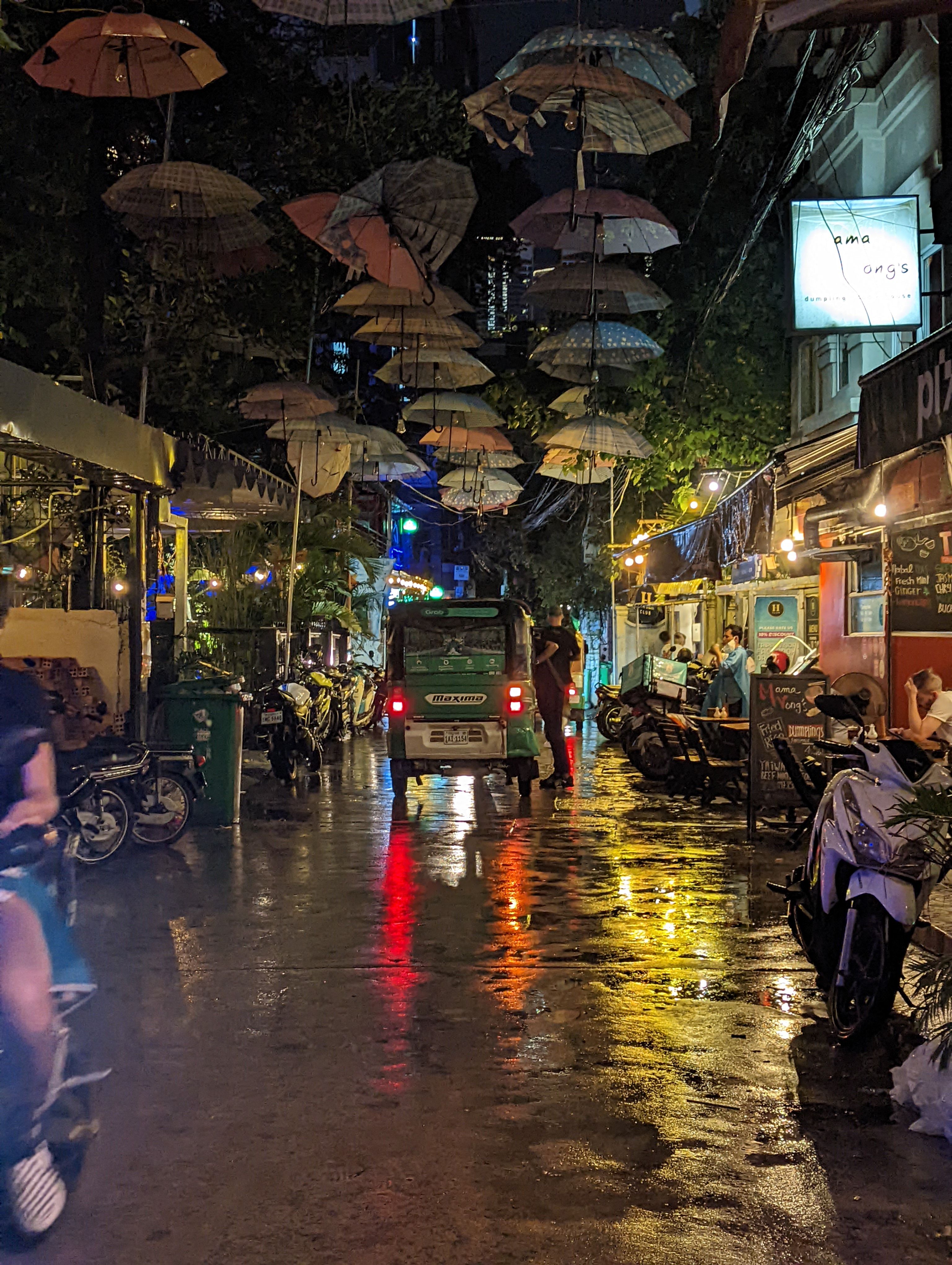
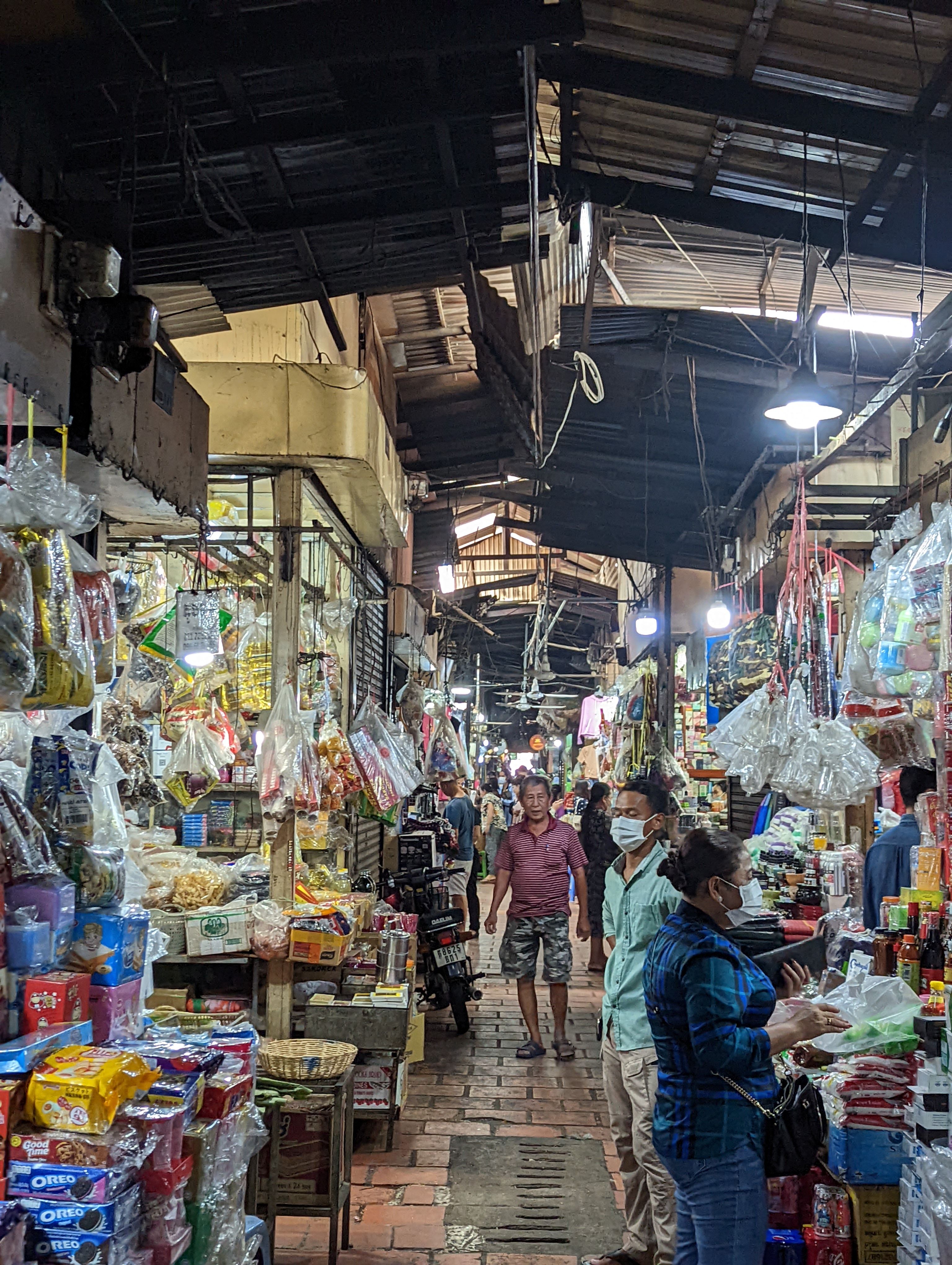 |
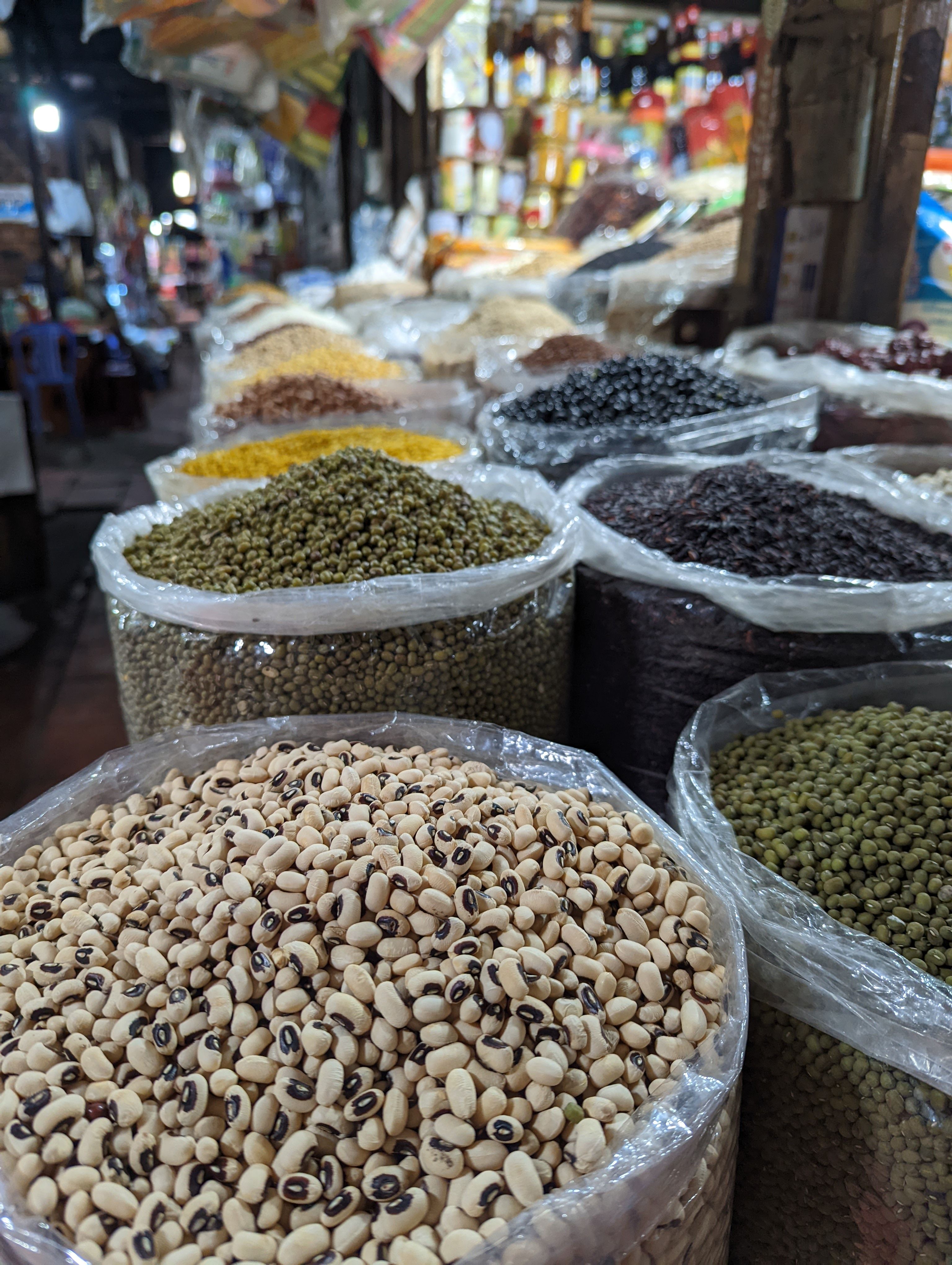 |
Tuol Sleng Genocide Museum (S21)
S21, the central node of the Khmer Rouge’s torture prison network, was harrowing, numbing. I don’t think I can write anything that will capture the essence of this place. The horrors that occured here are beyong comprehension.
Standing in the very rooms, cells, where the atrocities took place, I felt some sort of guilt for failing to feel, and I mean really feel what happened here. Something inbetween sorrow and numbness.
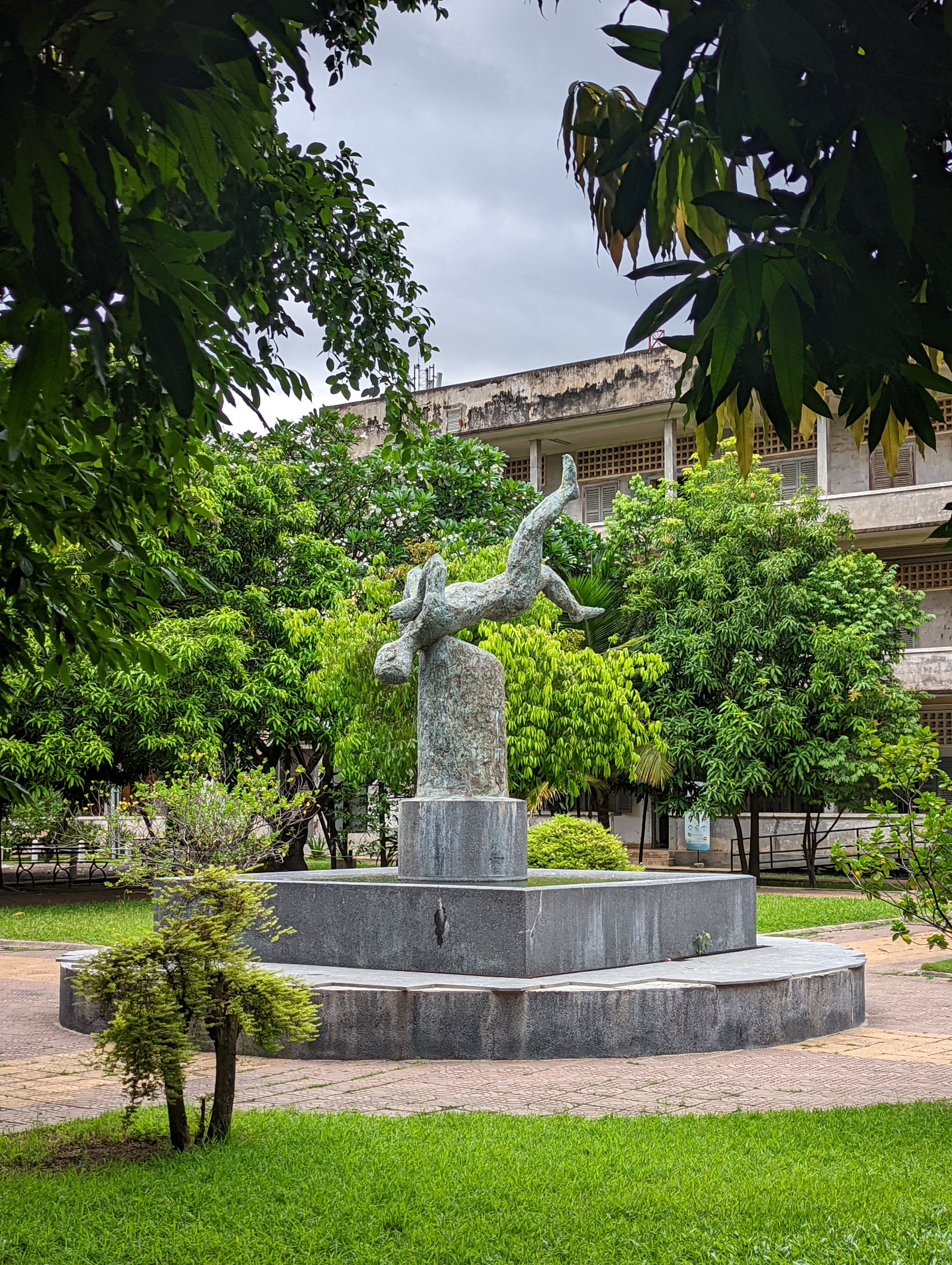
National Museum of Cambodia
The next day we visited the museum. In our messed up holiday routine, we rocked up at 11:30, which is when the museum closes for lunch; the same thing happened when we visited S21 the day before! We killed 2 hours by walking along the river all the way to Koh Pich island. There was nothing to see there.
The museum had some interesting artefacts, but overall it was pretty small. I genuinely don’t think the $10 entrance fee is justified. In fact, I think this museum easily falls in the “skippable” category.
Our visit happened to coincide with the (assistant) American Secretary of State’s visit, and that’s only relevant to us because a section of the museum was closed because of it.
The End?
This is where our Cambodia trip ended, somewhat prematurely. We had originally set aside the whole month of July for it, but after about 2 weeks we felt like we’d seen enough. Honestly, we felt really torn leaving – in some ways we felt like we hadn’t given it a chance – but we also had to try hard to relax and enjoy ourselves, which was a self-defeating exercise. We mulled over the decision for a long time, actively discussing why we’re feeling the way we were. It boils down to, in no particular order:
- Tourism was low, affected heavily by the pandemic and the incoming rainy season
- Higher prices for lower quality (be it food, accomodation or tourist attractions)
- A genuine lack of things to do and visit
Combine all 3 and you get low mood.
The last point is controversial and I don’t know how to feel about it. Is it true? Can I honestly say that if I only visited a handful of places? Our rough plan before the trip included a collection of landmarks, towns and beaches to visit.
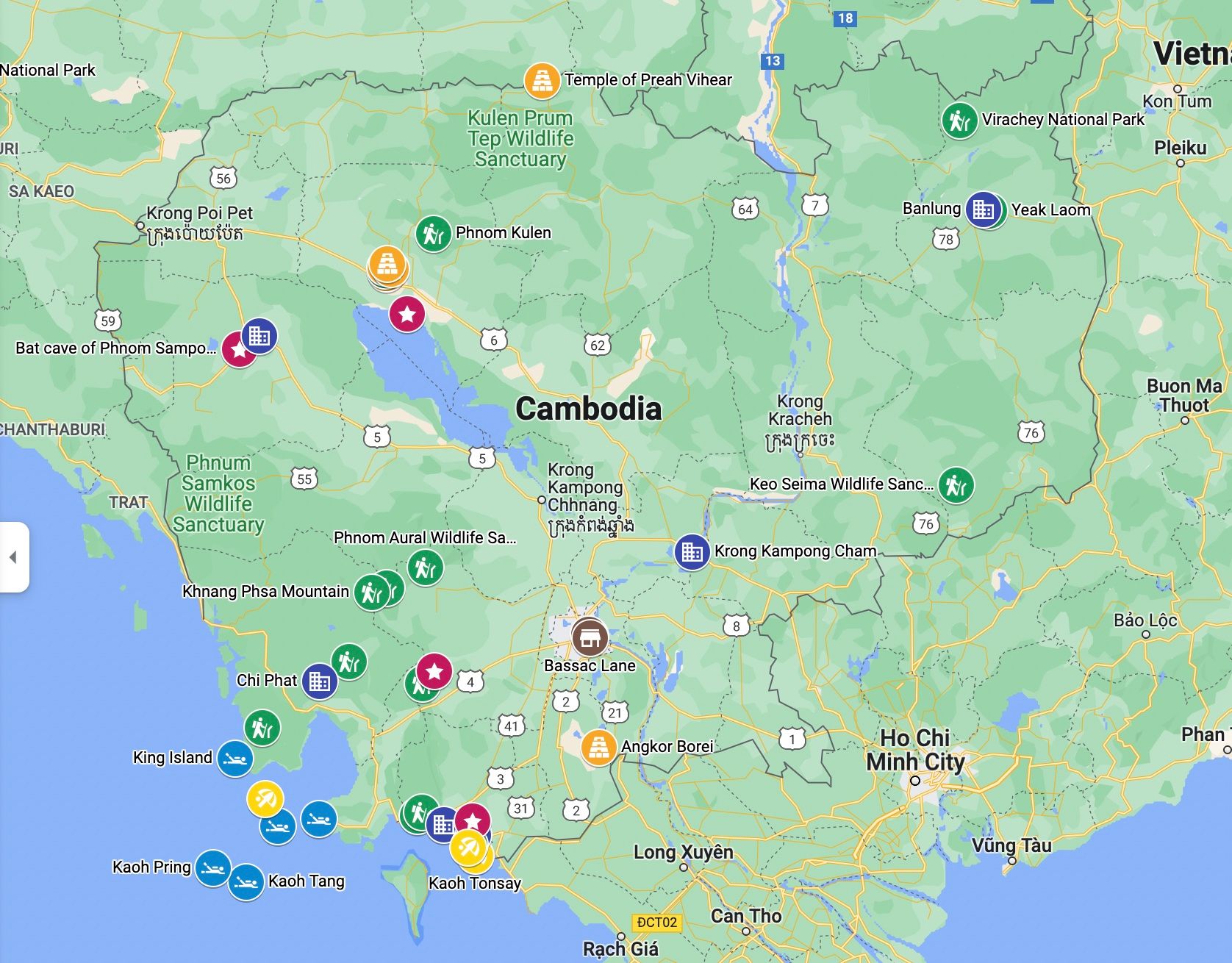 Certainly not a comprehensive list, but it includes more than just the regular tourist hotspots
Certainly not a comprehensive list, but it includes more than just the regular tourist hotspots
We marked plenty of places but the reality was that for a lot of them getting there was difficult (especially with limited options after the pandemic) and that the places themselves are just not all that great. Citation needed? Probably. For instance, take Virachey National Park. It’s far, remote and hard to get to (9h-12h bus trip from Phnom Penh) and ultimately we ended up asking ourselves… is it worth the effort? From what I saw online, it looks neat but it doesn’t look magnificent. Part of me is wincing as I type this because I may just be spouting bullshit, given that I didn’t actually go there myself. I am sure doing a multi-day hike there would be a cool experience but we didn’t feel excited enough by it.
And that’s what answered it for us in the end: if you have to invest more effort to feel good about a place than you get out of it, then maybe you ought to leave.
You could say that we just weren’t willing to spend enough to enjoy ourselves in Cambodia – perhaps that’s all it takes? I wouldn’t describe myself as tight (I am sure some people might), but I certainly don’t like being charged more than what I deem something is worth. And after Thailand, we kind of felt like we were getting taken advantage of in Cambodia. Again, this sounds monumentally stupid in isolation: the country and its citizens are so poor compared to us privileged travellers and I’m the one complaning about being taken advantage of… I suppose I’m still trying to dissect my feelings.
Backpacking, even in the slightly more budgeted way that we approach it, is not always easy. There is also this unexplicable lack of tolerance for “travel bullshit” that you start to exhibit as you get older, and you slowly start gravitating towards a more pampered holiday. I don’t like that. Yet, I don’t have the energy to stay in shitty hostels with loud 20-something-year-olds on their gap years.
Cambodia, I will return to you. You left me feeling torn. I am sure some would describe you as an uncut gem; perhaps I am still scrubbing the muck off you, hopeful for your glimmer.